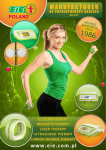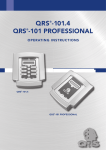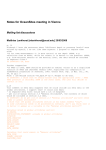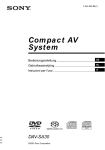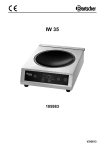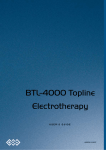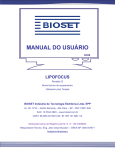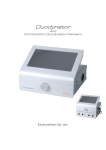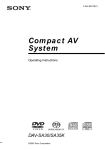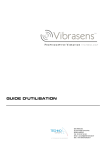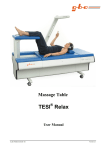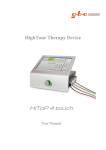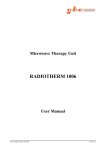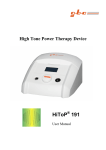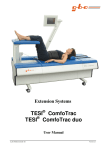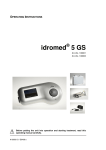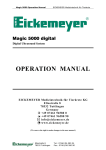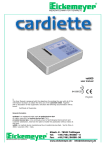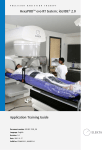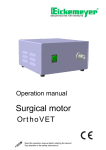Download STEREODYNATOR 928 - Frank`s Hospital Workshop
Transcript
Interference Current Stimulation Devices STEREODYNATOR 928 User Manual gbo Medizintechnik AG 2004 Version 1.9 STEREODYNATOR 928 2 Das vorliegende Handbuch wurde von der gbo Medizintechnik AG erstellt und auf seine Richtigkeit überprüft. Es erhebt jedoch keinen Anspruch auf Vollständigkeit. Alle Angaben und Daten können ohne vorherige Ankündigung geändert werden. Ohne ausdrückliche schriftliche Genehmigung der gbo Medizintechnik AG darf kein Teil dieses Handbuch für irgendwelche Zwecke vervielfältigt oder übertragen werden, unabhängig davon, auf welche Art und Weise oder mit welchen Mitteln, elektronisch oder mechanisch, dies geschieht. The gbo Medizintechnik AG has taken care in preparation of this manual, but makes no expressed or implied warranty of any kind and assume no responsibility for errors or omissions. All rights reserved. No part of this manual may be reproduced, in any form or by any means (electronic, mechanical, or otherwise) without the prior written permission of the gbo Medizintechnik AG. © gbo Medizintechnik AG 2004 gbo Medizintechnik AG Kleiststraße 6 D-64668 Rimbach Telephone:+49 / 6 25 3 / 808-0 Telefax: +49 / 6 25 3 / 808-300 E-Mail: [email protected] Internet: http://www.gbo-med.de gbo Medizintechnik AG 2004 Version 19 STEREODYNATOR 928 3 Comments According to the Medical Device Directive The STEREODYNATOR 928 is a mains operated current stimulation device of protection class I. The device is in accordance with the EC Medical Device Directive (93/42/EEC) and therefore carries the CE-sign with the number of the ”notified body for medical devices”. The according graphical symbol is placed on the type plate. According to the Medical Device Directive, STEREODYNATOR 928 is a device of class IIb. The manufacturer is only responsible for the security, operational reliability and functionality of the device if: • the device is used in accordance with the user manual; • the electrical installation of the location where the device will be used corresponds to the respective current requirements of electrical safety; • the device is not used in hazardous environments and humid locations; • the mountings, add ons, internal adjustments, modifications or repairs are realized only by personnel authorized for that by the manufacturer; • the operator regulation of this EC-directive is observed within the scope of the Medical Device Directive. You may obtain technical support by the manufacturer or the dealers or service authorized by the manufacturer. The manufacturer provides a life time of at least 10 years for this product. STEREODYNATOR 928 is a electronic device. Disposing has to be done according to regulations for electronic devices. Consumables have to be disposed as garbage. On request, the manufacturer will provide you with further technical descriptions for all serviceable parts of the device, such as circuit diagrams, spare part lists, and adjustment instructions as far as these are of use for the qualified technical staff of the user. Comments on electromagnetic compatibility (EMC) Medical, electrical devices are subject to special precautions concerning the EMC. They must be installed and operated according to the EMC-advice given in the accompanying documents. In particular medical, electrical devices may be influenced by portable and mobile RF-communication devices. The manufacturer guarantees the conformity of the unit with the EMC-requirements only when using accessories which are listed in the EC declaration of conformity. The usage of other accessories my cause an increased emission of electromagnetic disturbances or may lead to a reduced electromagnetic immunity. The unit must not be arranged physically close to other devices or stacked with them. If such an order is necessary nevertheless, the unit must be observed in order to check it for the intentional operation. You find more EMC-comments in the chapter “Warnings and Safety Precautions” of this manual as well as in the Technical Information on the next two pages. gbo Medizintechnik AG 2004 Version 1.9 STEREODYNATOR 928 4 In accordance with the EMC-regulations for medical products we are obliged by law to provide the following information. Guidance and manufacturer’s declaration — electromagnetic emissions The equipment is intended for use in the electromagnetic environment specified below. The customer or the user of the equipment should assure that it is used in such an environment. Emissions test Compliance Electromagnetic environment – guidance RF emissions, CISPR 11 Group 1 The equipment uses RF energy only for its internal function. Therefore, its RF emissions are very low and are not likely to cause any interference in nearby electronic equipment. The equipment is suitable for use in all establishments, including domestic establishments and those directly connected to the public low-voltage power supply network that supplies buildings used for domestic purposes. RF emissions, Class B CISPR 11 Harmonic emissions, Class A IEC 61000-3-2 (*) Voltage fluctuation/flicker Complies emissions, IEC 61000-3-3 (*) (*) Note: For devices with a power consumption between 75 W and 1000 W only. Guidance and manufacturer’s declaration — electromagnetic immunity The equipment is intended for use in the electromagnetic environment specified below. The customer or the user of the equipment should assure that it is used in such an environment. Immunity test IEC 60601- test level Compliance level Electromagnetic environment – guidance Electrostatic discharge (ESD), IEC61000-4-2 Electrical fast transient/burst, IEC 61000-4-4 Surge, IEC 61000-4-5 Voltage dips, short interruptions and voltage variations on power supply input lines, IEC 61000-4-11 Power frequency (50/60 Hz) magnetic field, IEC 61000-4-8 ±6 kV contact ±6 kV contact ±8 kV air ±8 kV air ±2 kV for power supply lines ±2 kV for power supply lines ±1 kV for input/output lines ±1 kV differential mode ±1 kV for input/output lines ±1 kV differential mode ±2 kV common mode <5% Uτ for ½ cycle (>95% dip) ±2 kV common mode <5% Uτ for ½ cycle (>95% dip) 40% Uτ for 5 cycles 60% dip) 40% Uτ for 5 cycles 60% dip) 70% Uτ for 25 cycles 30% dip) 70% Uτ for 25 cycles 30% dip) <95% Uτ for 5 s (>5% dip) <95% Uτ for 5 s (>5% dip) 3 A/m 3 A/m Floors should be wood, concrete or ceramic tile. If floors are covered with synthetic material, the relative humidity should be at least 30 %. Mains power quality should be that of a typical commercial or hospital environment. Mains power quality should be that of a typical commercial or hospital environment. Mains power quality should be that of a typical commercial or hospital environment. If the user of the equipment requires continued operation during power mains interruptions, it is recommended that the equipment be powered from an uninterruptible power supply or a battery. Power frequency magnetic fields should be at levels characteristic of a typical location in a typical commercial or hospital environment. Note: Uτ is the a.c. mains voltage prior to application of the test level. gbo Medizintechnik AG 2004 Version 19 STEREODYNATOR 928 5 Guidance and manufacturer’s declaration — electromagnetic immunity The equipment is intended for use in the electromagnetic environment specified below. The customer or the user of the equipment should assure that it is used in such an environment. Immunity test IEC 60601- test level Compliance level Electromagnetic environment – guidance Portable and mobile RF communications equipment should be used no closer to any part of the equipment, including cables, than the recommended separation distance calculated from the equation applicable to the frequency of the transmitter. Conducted RF, IEC 61000-4-6 Radiated RF, IEC 61000-4-3 3 Vrms 150 kHz to 80 MHz 3 V/m 80 MHz to 2,5 GHz Recommended separation distance: d=1,2√P 3 Veff 3V/m d=1,2√P for 80 MHz to 800 MHz d=2,3√P for 800 MHz to 2,5 GHz Where P is the maximum output power rating of the transmitter in watts according to the transmitter manufacturer and d is the recommended separation distance in meters (m). Interference may occur in the vicinity of equipment marked with the following symbol: Recommended separation distances to portable and mobile RF communication equipment The equipment is intended to be operated in an electromagnetic environment, where radiated RF interference is controlled. The user can help in avoiding interferences by means of meeting minimum separation distances between portable and mobile RF communication equipment (transmitters) according to the maximum output power of the communication equipment. Rated power of the Separation distance according to the tranmission frequency (m) transmitter (W) 150 kHz to 80 MHz 80 MHz to 800 MHz 800 MHz to 2,5 GHz d=1,2√ √P d=1,2√ √P d=2,3√ √P 0,01 0,12 0,12 0,23 0,1 0,38 0,38 0,73 1 1,2 1,2 2,3 10 3,8 3,8 7,3 100 12 12 23 gbo Medizintechnik AG 2004 Version 1.9 STEREODYNATOR 928 6 EC - DECLARATION OF CONFORMITY Name of manufacturer : gbo Medizintechnik AG Address : Kleiststrasse 6 D - 64668 Rimbach Germany We hereby declare under our sole responsibility that the product described below conforms in design and make as well as in the versions delivered to the corresponding safety and protection requirements defined in the applicable EC regulations. Harmonized standards have been used for all conformity checks, national standards have not been applied. Any change to the product design that is not validated by us will render this declaration invalid. Type of product : Stimulation Current Unit Label : STEREODYNATOR 928 Options : Ultrasound therapy module Suction application module Accessories Corresponding EC regulations : Description Bow electrode Handle with finger-tip Rubber electrode 3 x 4 cm2 Rubber electrode 6 x 8 cm2 Rubber electrode 8 x 12 cm2 Tin plate electrode 9 x 12 cm2 Patient cable Suction electrode 34 mm Suction electrode 70 mm Suction electrode 50 mm Ultrasound probe 2,5 cm2 Ultrasound probe 5 cm2 Vaginal electrode Rectal electrode Star electrode small Star electrode standard Star electrode large Stereo suction electrode Part-No. 014-0-928 Part-No. 014-0-928-U Part-No. 014-0-928-V Part-No. 011-0-0024 45-38-401EH725 45-38-880EH725 45-38-898EH725 45-38-492EH725 45-38-468EH725 45-38-435EH725 45-38-518EH722 45-38-526EH722 45-38-500EH722 023-0-0140 023-0-0141 014-0-0006 014-0-0007 45-38-708EH725 45-38-716EH725 45-38-724EH725 45-38-856EH722 : EC medical devices directive (93/42/EEC) Conformity assessment procedure : Annex II of the directive 93/42/EEC Classification : IIb (according to MDD, appendix IX) Name und registration no. of the notified body : TÜV Product Service in Munich/Germany with the registration no. 0123 Additional information : none Date : January-1, 2006 Name of persons responsible : Dr. Eberhard Keck Title/Function : CEO Signature : gbo Medizintechnik AG 2004 Version 19 STEREODYNATOR 928 7 Notations Times New Roman in type size 11 - descriptions and explanations Arial in type size 10 - functions and keys of the current stimulation device Lucida in type size 11 - text appears on the display of the current stimulation device [Descriptions]] - text appears on the display next to the soft key Pictographs Attention Warnings which have to be observed by all means ! Attention ! Observe the instructions for use ! !! Note Information that will facilitate your work. gbo Medizintechnik AG 2004 Version 1.9 STEREODYNATOR 928 8 Table of Contents OVERVIEW 11 1 12 2 3 4 INTRODUCTION 1.1 Intended Use 12 1.2 Operating Concept 14 1.3 Short Instructions 15 1.4 Modes of Action of the Therapeutic Current Types 17 START OF OPERATION 18 2.1 Transport and Assembly 18 2.2 Connection and Switch-On 18 2.3 Settings 2.3.1 Device Settings 2.3.2 Basic Settings of the Current Types 19 19 20 DESCRIPTION OF FUNCTION 21 3.1 Operating Notes 3.1.1 Optical and Acoustical User Support 3.1.2 Intensity Regulator 3.1.3 Current and Polarity 3.1.4 Surge Parameters 3.1.5 Galvanic Base 3.1.6 Frequency Lock 3.1.7 Pulse Parameter 3.1.8 Therapy Time 3.1.9 Stimulation shifting 3.1.10 Menu 3.1.11 Menu Programs 21 21 22 22 24 24 24 25 25 26 27 28 3.2 Integrated Suction Application Aid 29 3.3 Ultrasound Therapy Module 30 THERAPY 32 4.1 Therapy with interference currents 4.1.1 Sedat 4.1.2 Myomot 4.1.3 Vegetative Stimulation I 4.1.4 Vegetative Stimulation II 4.1.5 Vegetative Stimulation III 4.1.6 Universal 4.1.7 Sedation Modulation 4.1.8 Automated programs 32 32 33 33 33 33 33 33 34 4.2 Menu Application With Electrotherapy 35 4.3 Menu ‘Applications with ultrasound’ 36 4.4 ”One - Touch” - Operation 4.4.1 Diadynamic Currents 4.4.2 Strong Muscle Stimulation (SMS) According to Eichhorn 4.4.3 Middle Frequency Currents 4.4.4 Ultrastimulation Current 36 36 37 37 38 gbo Medizintechnik AG 2004 Version 19 STEREODYNATOR 928 4.4.5 4.4.6 4.4.7 4.4.8 4.4.9 4.4.10 4.4.11 High-Voltage Currents Galvanic Current and Iontophoresis Faradic Current Transcutaneous Electrical Nerve Stimulation Transcutaneous Electrical Nerve Stimulation With Impulse Groups Micro-Stimulus Current Universal Therapy 9 38 39 40 40 41 42 42 4.5 Special types of current Menu 4.5.1 Impulse Galvanization 4.5.2 Frequency Modulation 4.5.3 Diadynamic Currents MF Monophasé Fixe and LP Longues Périodes 4.5.4 Rectangular Current for Incontinence 42 43 43 43 43 4.6 GYM 4.6.1 GYM current 4.6.2 GYM Training 4.6.3 Burning mode 44 44 45 45 5 GALVANOPALPATION 46 6 ELECTROKINETIC THERAPY 47 7 6.1 Detection of Trigger Points With the Electrode Handpiece 47 6.2 Stimulation Massage 47 ELECTRODES 48 7.1 Electrode Positioning 7.1.1 Monophase Electrode Techniques 7.1.2 Biphase Electrode Techniques 48 49 49 7.2 Single-Pole Electrodes 49 7.3 Three-pole electrodes 51 7.4 Suction Electrodes 51 7.4 Suction Electrodes 52 7.5 Electrode Handpiece 52 8 TROUBLESHOOTING 53 9 MAINTENANCE 54 9.1 Safety Controls 54 9.2 Cleaning, Disinfection and Care 9.2.1 Current Stimulation Device 9.2.2 Electrode Fleece, Electrode Pockets or Felts 54 54 54 10 WARNINGS AND SAFETY PRECAUTIONS 55 11 EXPLANATION OF THE SIGNS USED 57 12 TECHNICAL DATA 58 13 ACCESSORIES 61 INDEX 57 gbo Medizintechnik AG 2004 Version 1.9 10 APPENDIX: STORING OF THERAPEUTIC CURRENT TYPES gbo Medizintechnik AG 2004 STEREODYNATOR 928 59 Version 19 STEREODYNATOR 928 11 Overview Chapter 1 describes the basic characteristics of the current stimulation device. Chapter 2 explains the start of operation of the current stimulation device. It describes its setting possibilities. Chapter 3 describes all functions of the device and their operation. Chapter 4 explains the realization of therapies. Chapter 5 explains the realization of galvanopalpation. Chapter 6 explains the realization of electrokinesis. Chapter 7 refers to the arrangement and the use of the electrodes. Chapter 8 explains the error messages and gives some hints in the case of faults. Chapter 9 refers to safety controls in accordance with the MDD and to routine maintenance. Chapter 10 shows the possible threats when using the current stimulation device. Furthermore, it indicates how to avoid possible threats. Chapter 11 explains the signs used. Chapter 12 speifies all relevant technical data of the current stimulation device. Chapter 13 shows the scope of supply of the device and informs about further accessories indicating their order number. gbo Medizintechnik AG 2004 Version 1.9 STEREODYNATOR 928 12 1 Introduction 1.1 Intended Use The devices with interference current are microprocessor controlled electrical stimulus devices for Electro Therapy. Their wide range of usage predestinates these medical devices for use in physiotherapeutic departments of clinics as well as in modern well-equipped private practices. The devices with interference current represent a continued development, based on the 8th series equipment. All accessories of the 8th series can also be used with the 9th generation in the same manner. A suction application aid for vacuum therapy as well as a module for ultrasound therapy with continuous and impulse ultrasound waves are optionally available. The control elements for suction application aid and ultrasound have already been integrated on the keyboard. A stereodynamic interference current is generated through the superposition of three middle-frequency currents flowing in different directions. The stimulating lower frequencies are already generated through interference of two phase shifted circuits in the area being stipulated. The additional third circuit generates, as opposed to classical interference methods, on one side a slow change in intensity and on the other side a rhythmic shifting of the interference field. These dynamics of the stimulation location and the intensity dynamics decrease the habituation effect and therefore improve the therapeutic effect. The STEREODYNATOR 928 uses the three-dimensional interference method. The special characteristics are as follows: • • • • Local stimulation effect. Multi-site stimulation effect. Intensity dynamics. Dynamic behavior of stimulation site coupled with endogenous/exogenous stimulation shifting. Automated programs improve the handling: The STEREODYNATOR 928 is equipped with several programs which automatically adjust the treatment frequency and the treatment time. Treatment frequencies, particularly for sedation, myokinetics and vegetative stimulation, are available. The stimulating effect can alternatively be administrated endogenously or exogenously. During endogenous application, the interference is generated through superposition of the electrical circuits in the body. This allows an intense effect. During exogenous application, the interference is created in the medical device. The stimulating effect takes place directly underneath the electrodes on the body surface. In addition to the three-circuit interference current, STEREODYNATOR 928 offers a complete selection of single circuit currents for all known therapeutic procedures. gbo Medizintechnik AG 2004 Version 19 STEREODYNATOR 928 13 The STEREODYNATOR 928 is particularly suitable for: • Pain therapy with three-dimensional interference current. • Muscle toning and muscle detoning. • Galvanization and iontophoresis. • Pelvic floor stimulation. • Treatment of urinary and fecal incontinence. • Neurodiagnostic examination with galvano-palpations. • Treatment of paralyses with complete or partial muscular degeneration. • Treatment of atrophies due to inactivity or weakened muscles after longer periods of inactivity. • Electrical stimulation therapy without electrolytic side effects and only slight muscle fatigue. • Treatment of pain, muscle spasms, functional diseases of the locomotor system, such as sports injuries, peripheral circulatory disturbances, influencing of the vegetative system with diadynamic currents, ultrastimulation current, microstimulation current, TENS- and TENS Burst currents, high-voltage currents and middle-frequency currents. gbo Medizintechnik AG 2004 Version 1.9 STEREODYNATOR 928 14 1.2 Operating Concept ”One-Touch”-Philosophy Immediately after pushing the key for the desired current type, the therapy or diagnosis can be started. Ergonomic Control Panel Function keys are colored black and modification keys are white. Keys for identical functions on different models are located in the same position on all devices. They are easy to recognize – which is particularly important for the visually handicapped - and also have a pressure point. The parameter settings can be carried out with keys or the modification knob. The modification knob has an upper and lower limit stop by software. So the values can only be modified in a defined range of values even by overturning the knob. The according limit stop can be equipped with a signal tone with the device setting, see chapter 2.3.1 . In case of key operating there is no limit stop; after the last setting possibility it will restart with the first one. Here it is also possible to have a key click by the appropriate device setting, see chapter 2.3.1. After the expiration of the therapy time, the current to the patient automatically is switched off and the intensity is set to ”0.0”. Display All devices are equipped with a high-resolution graphic display. The selected stimulation current type is shown graphically. The parameters are also shown. They are modified using the white modification keys located around the display or by the modification knob. LED keys Optical user support is furnished in the form of LED lights incorporated into the keys: ∗ flashing key was selected and remains active ∗ constantly lit key is active and operational ∗ not lit key is not active and not operational Menu In addition to the ”One-Touch” operation, a user-guided method for selection can also be chosen by way of the menu. By selecting the desired effect (analgesia, hyperemia, muscle toning, muscle detoning) and the site of action (head and neck, spinal column and trunk, upper extremities, lower extremities), the appropriate current type is automatically selected and a recommendation for the electrode application is provided. The menu also allows the use of special types of current. gbo Medizintechnik AG 2004 Version 19 STEREODYNATOR 928 1.3 15 Short Instructions mono-/biphase pulse rise Galv. base Operation mode Therapy time Types of therapy stimulation currents Ultrasound therapy unit* End./ex. change Graphic display Menu Polarity Frequency lock Pulse-/Pause duration Soft key Modificationknob Suction aid forvacuum therapy* Surge parameter Patient cable connection and/or vacuum cable I = socket (1) Stereodynamic interference currents Stim. frequency Intensity knob Automatic programs Application part ungrounded, protection BF Attention! Observe the instructions for use ! Vacuum cable II = socket (2) Connection for ultrasound probe* = socket (3) Carrying handle Service interface Mains switch Power inlet Fuses and voltage selector *) depending on unit configuration Figure 1: STEREODYNATOR 928 gbo Medizintechnik AG 2004 Version 1.9 16 STEREODYNATOR 928 1. Switch on with the mains switch at the back of the device. The device carries out an automatic test of all its functions. The faultless selftest ends with the acoustic signal. 2. Connect the accessories with the according socket on the right side of the device. 3. Optical user support is furnished in the form of LED lights incorporated into the keys: ∗ flashing key was selected and remains active ∗ constantly lit key is active and operational ∗ not lit key is not active and not operational 4. The three-ray star display serves as stimulation frequency display and electrode contact display. The green luminous bars are lit in the three circuit mode and show the frequencies effective in the body. The red LEDs indicate: ∗ Red LEDs lit there is current flowing ∗ Red LED not lit there is no current flowing 5. Furthermore, an acoustic user support is furnished ∗ Confirmation beep 1 x - admissible pressing of a key ∗ Information sound 1 x - inadmissible pressing of a key - disconnection of the patient plug during operation ∗ Alarm ca. 2 s - insufficient electrode contact, dropping electrodes during the therapy (CC) - in case of unintended current increase during therapy ∗ Triad-gong 1x - at the beginning of the automatic check to control the gong 3x - at the end of therapy - the key of the electrode handpiece has not been pressed for 2 min - in operating mode CV no current has flown for 2 min 6. Put the electrodes on to the patient (exception: in case of using the suction application aid the Vacuum key and the Types of stimulation current key have to be pressed first). 7. Select the current type by pressing the corresponding current key or select it from the Menu. 8. The default setting of the current type is activated automatically. 9. Select additional modifications: • By pressing the desired Modification key. • By turning the Modification knob or repeatedly pressing of the Modification key until the desired value has been set. 10. Increase the current slowly with the Intensity regulator until the desired stimulation effect occurs. 11. At the end of the therapy the triad gong will sound three times. The current to the patient will be faded out within 10 s. gbo Medizintechnik AG 2004 Version 19 STEREODYNATOR 928 1.4 17 Modes of Action of the Therapeutic Current Types Current Galvanic current Ultrastimulation current Faradic current Strong muscle stimulation Micro-stimulus current Universal therapy Diphasé fixe Courtes périodes MF I / surged Key Galv UR F1 SMS Micro T/R Grafics I II III IV Current Tens Burst I / 50 Hz Tens Burst V / 100 - 200 Hz Special currents Longues périodes LP Impulse galvanization IG 30 Impulse galvanization IG 50 / surged Frequency modulation FM / 7 - 14 Hz MF V / 10 - 30 Hz Stereodynamic Interference currents MF VI / 30 - 60 Hz Sedat 200 Hz MF VII / 100 - 200 Hz Myomot 50 Hz HV... … With depth effect Vegetat. Stim I 2.5 - 25 Hz Vegetat. Stim II 10 Hz HV II / 3 -10 Hz HV III / 10 - 30 Hz Vegetat. Stim III 0.1 - 1 Hz HV IV / 30 - 60 Hz Universal 1 - 200 Hz HV V / 100 - 200 Hz Tens I / 100 Hz Menu Incontinence MF IV / 3 - 10 Hz HV I / 50 Hz II III IV Tens Burst IV / 30 - 60 Hz CP MF III / 50 Hz I Tens Burst III / 10 - 30 Hz Monophasé fixe MF MF II / sinus surged Grafics Tens Burst II / 3 - 10 Hz DF MF... Key Tens Burst... Tens... Tens II / 3 - 10 Hz No effect Good effect Slight effect Very good effect Analgesia Hyperämia III Muscle toning IV Muscle detoning Tens III / 10 - 30 Hz I II Tens IV / 30 - 60 Hz Table 1:Modes of action of the therapeutic current types Tens V / 100 - 200 Hz gbo Medizintechnik AG 2004 Version 1.9 STEREODYNATOR 928 18 2 Start of Operation 2.1 Transport and Assembly The current stimulation device is a portable unit. There is a carrying handle in the form of a recessed grip in the base plate. To place the unit, each flat surface is appropriate. A wall distance of at least 20 cm has to be provided. The device should not be placed in front of radiators. The current stimulation device corresponds to the regulations DIN/VDE 0750, EN 60601. It is a device of protection class I. Within the scope of the Medical Device Directive (MDD) the current stimulation device belongs to class IIb (see also chapter 10 Warnings and Safety Precautions). Attention The unit is not designed to be operated in places with the inherent risk of explosions. If it is used in dangerous areas of anesthesia departments, the possibility of an explosion cannot be excluded. If the patient and/or the patient cable is directly exposed to a radiator of a medical device for high frequency heat therapy, the damage of the device or a danger to the patient cannot be excluded. As a rule, a distance of 3 m is sufficient. 2.2 Connection and Switch-On The current stimulation device has been adjusted for the connection to a supply voltage of 230 V. If needed, the device can be switched over to the following supply voltages: • 240 V • 230 V • 120 V • 100 V. Irrespective of the adjusted supply voltage, the device is appropriate for mains frequencies of 48 to 62 Hz. Voltage Selection and Fuses: 1. Unplug the mains plug. 2. The device is protected by 2 fuses on the mains side that are located in a pluggable box at the back of the device next to the power inlet (see Figure 1). 3. The adjusted supply can be seen through the small window of the box. 4. With a screw driver the box can be pulled out of the line filter unit by the small slot. 5. Remove the voltage selector out of the holder and set the usual supply voltage. gbo Medizintechnik AG 2004 Version 1.9 STEREODYNATOR 928 19 Attention The mains socket has been sealed with a scotch tape. This is to remember to check prior to switch-on, whether the adjusted voltage corresponds to the supply voltage of the treatment room. The scotch tape over the mains socket is easy to remove. Connect the current stimulation device with the mains cable to a (grounded) safety power outlet. The current stimulation device is switched on by the mains switch at the back of the device. By this arrangement erroneous, unintended disconnection of the device during normal operations shall be avoided. After switching on the device, an automatic selftest of all device functions will be performed (see chapter 1.3 Short Instructions). 2.3 Settings 2.3.1 Device Settings Once the unit has been switched on and is ready, you can start immediately with the standard settings. Device settings Signal for adjustment knob Signal for keys Max. value of therapy time Ultrasound power emission Automatic pump switch off Signal volume Language Contrast of display Inverse representation Display mode of action Therapy time adjustment Vacuum default intensity Table 2: Setting possibilities yes / no yes / no 20 min / 40 min W / W/cm2 yes / no bargraph 0 - 15 German English Italian Portuguese Spanish Czech French 0 - 15 yes / no yes / no 1 min – max. value 0 % - 100 % Delivery yes yes 20 min W/cm2 Yes 7 German 7 No yes standard 0% Device settings gbo Medizintechnik AG 2004 Version 1.9 STEREODYNATOR 928 20 If you would like to change them, please proceed as follows: 1) Press the black Menu key. 2) You are in the Main menu. 3) Move the scroll bar with the Modification knob to Device settings. 4) Confirm by pressing the white Soft key. 5) You are in the Device settings menu. 6) Move the scroll bar with the Modification knob to the device setting to be changed. 7) Confirm by pressing the white Soft key. 8) Move the cursor with the Modification knob to the desired value. 9) Confirm by pressing the white Soft key. 10) Exit the Device settings menu by pressing the black Menu key. 11) On the display the Main menu appears again. !! Note On Vacuum default intensity setting the pump is switched off, if no suction electrodes are connected. If suction electrodes are connected the pump will run corresponding to the set value. 2.3.2 Basic Settings of the Current Types Upon pressing the desired current type key, the default settings for this current type are set. Altered parameters are canceled by pressing the current type key again, i.e. the default settings are available again. Modifications will not be stored. !! Note If the default settings for the therapy time have been modified by therapy time adjustment, the new settings are permanently stored and recalled each time after pressing the current type key. gbo Medizintechnik AG 2004 Version 1.9 STEREODYNATOR 928 21 3 Description of Function 3.1 Operating Notes Each current type can be modified specifically. Certain modifications can be set only when the intensity control is ”0.0”. Other modifications can be set also during therapy. Please observe the acoustical and optical user support. 3.1.1 Optical and Acoustical User Support Optical user support is furnished in the form of LEDs incorporated into the keys: LED Flashing Constantly lit not lit Condition of the key key was selected and remains active key is active and operational key is not active and not operational Table 3: Optical user support Furthermore, optical user support is furnished on the display: • A modification which is just being changed is shown inversely. • If in case of a current type Pulse duration T and/or Pause duration R are modifiable, only the letter T and/or R will be shown under the current type diagram. The numerical values are shown next to the Pulse duration key and/or Pause duration key, see Figure 12 and Figure 13. • If in case of a current type Pulse duration T and/or Pause duration R are not modifiable, the numerical values are shown under the current type diagram. Star display: Interferenz Figure 2: Three-ray star display The three-ray star display has multiple functions and serves as stimulation frequency display and electrode contact display. In case of single-circuit mode, the star display is switched off. The green luminous bars indicate the stimulation frequencies. In case of the three-circuit mode, all three bars are lit. If stereodynamic interference current is applied, they show the beat frequencies effective in the body. The vertical bar shows the interference between circuit 1 and circuit 2, the left bar between circuit 2 and circuit 3, and the right bar between circuit 1 and circuit 3. gbo Medizintechnik AG 2004 Version 1.9 STEREODYNATOR 928 22 The red LEDs in the center of the star are lit, when current is flowing. Without current flowing, all red LEDs are turned off. The following table explains the acoustic signals and their meaning: Type of signal Confirmation ”beep” Information sound Alarm Triad gong Cause • in case of an admissible key operation 1× • in case of an inadmissible key operation 1× • in case of disconnecting the patient plug during operation approx. 2 s • in case of insufficient electrode contact and dropping electrodes during therapy (CC) • in case of unintended current increase during therapy (CV) • at the beginning of the automatic check to control the 1× gong • at the end of therapy 3× • if in manual operation the key has not been pressed for 2 min • if in ”CV” there was no current flows for 2 min Table 4: Acoustical user support 3.1.2 Intensity Regulator The Intensity regulator serves for setting the current intensity. It is furnished in the form of a incremental encoder. The current increases by turning right (in + direction) and it is reduced by turning left (in direction). The numerical value is shown on the display. The current value can be set in the following steps: • Galvanic Current, Micro-Stimulus Current → 0.1 mA • all the rest of therapy current types → 0.5 mA. !! Notes • The Intensity regulator automatically reverts to ”0.0” after the expiration of the therapy time. • When changing over from one current type to another, the Intensity regulator has to be set to ”0.0”. Control the current indication on the display. 3.1.3 Current and Polarity On the display, both the peak value of the stimulation current in mA peak as well as the polarity + and/or – are shown. The polarity sign always refers to the red plug of the accessories. The polarity change over is not active in case of biphase currents. When selecting biphase currents the polarity sign disappears. + 12.5 mA peak Figure 3: +/- Current indication on the display with the Polarity key gbo Medizintechnik AG 2004 Version 1.9 STEREODYNATOR 928 23 Automatic pole changing: By pressing the Polarity key polarity changes as follows: 1. Press → automatic pole changing, at first the polarity is positive (”+” flashes) and reverts to negative (”-” flashes) after half of the therapy time. 2. Press → polarity changes from positive to negative. 3. Press → polarity is positive again. When the polarity changes, the current will be faded out and restored again within 10 s. In case of combination of the current types DF and CP, polarity will be changed after half of the therapy time. !! Notes • The automatic pole changing can only be set before starting the therapy. • During therapy however, the polarity can be changed by pressing the Polarity key. By this, the current will also be faded out and restored again within 10 s. Monophase current: / Figure 4: Monophase current The current flows only in one direction. Biphase current: / Figure 5: Biphase current Each pulse consists of two parts with different polarities. Current display in CC-Mode: CV/CC CC Figure 6: Operating mode key as displayed on the screen The current set with the Intensity regulator remains constant even when the patient resistance changes. The display shows the peak value that is also constantly shown during puls pauses. A dynamic current limiter reduces the released current and/or the voltage to such a minimal deviation from the set value, that this will not lead to any comfort losses for the patient even in irregular application modes. Therefore, the operating mode CC can be used without any comfort limitations. There are no voltage sensations even in case of insufficient electrode contact or dropping electrodes. gbo Medizintechnik AG 2004 Version 1.9 STEREODYNATOR 928 24 Display in CV-Mode: CV/CC CV Figure 7: Operating mode key as displayed on the screen Constant voltage is set with the Intensity regulator. The value of the current to the patient depends on the patient resistance. The value of the Voltage is shown in V peak. !! Note In CV-Mode the intensity will be shown in V peak not in mA peak. 3.1.4 Surge Parameters Some current types can be surged individually by a surge cycle. The three surge parameters rise time duration time pause time determine a surge cycle. Each surge parameter can be changed within 0 to 60 s in steps of 0.5 s. The descent time in each surge cycle is always set to 1 s constantly. 2 s Figure 8: 3 6 s s Surge parameter key with the according displays 3.1.5 Galvanic Base Basis autom 0% Figure 9: Galvanic Base key with its display The current types DF, CP, MF and LP can be underlayed by a d.c. current whose amplitude corresponds to 20 % and/or 50 % of the peak current. By repeatedly pressing the key it can be changed between 0 %, 20 % and 50 % of the d.c. current underlaying. This is shown on the display. 3.1.6 Frequency Lock FIX 3 5 10 Frequency Hz Figure 10: FIX key with the display of the fixed therapy frequency gbo Medizintechnik AG 2004 Version 1.9 STEREODYNATOR 928 25 In case of frequency modulated current types, the frequency can be locked and released with this key during the treatment. The first key pressure locks, another actuation releases the frequency. !! Note If you want to modify the frequency, please press the white Soft key [frequency]]. The frequency now can be modified step by step with the modification knob. The frequency can be modified by turning the modification knob. Herewith also changes the pulse and/or pause duration. The according times change in the current type display and will not be shown by the T and/or R display. 3.1.7 Pulse Parameter Pulse rise: Figure 11: Pulse rise key as displayed on the screen The stimulation impulses can be modified in 5 steps to a rectangular, trapecoidal or triangular shape. Setting possibilities for the pulse duration and pause duration: 4.0 ms 16 T ms R Figure 12: Pulse duration key as displayed on the display Figure 13: Pause duration key as displayed on the display Pulse duration T and pause duration R can be modified before and during the treatment: • If in case of a current type Pulse duration T and Pause duration R are modifiable, only T and R will be shown under the current type diagram. The numerical values are shown above the Pulse duration key and/or the Pause duration key. • If in case of a current type Pulse duration T and Pause duration R are not modifiable, the letters T and R will be shown with the according numerical values under the current type diagram. • The pulse and/or pause duration can be modified via the frequency by pressing the FIX key. The according times change in the diagram and are not shown above the T and/or R keys. • If for pulse duration T or pause duration R there have been set higher values than 9000 ms, the unit will change from ms to s. 3.1.8 Therapy Time 05:00 Min Sec Therapy Timer 0 10 20 30 Figure 14: Therapy time key as displayed on the display gbo Medizintechnik AG 2004 Version 1.9 STEREODYNATOR 928 26 You can set the therapy time as follows: 1. Depending on the current type an appropriate therapy time will be suggested. 2. If you want to change the therapy time, press the Therapy time key. The time can be modified in steps of 1 minute. The maximum therapy time to select is 40 min (see chapter 2.3.1 Device Settings). 3. Set the desired therapy time: • By repeatedly pressing the Therapy time key or • By using the Modification knob. !! Notes • The selected or given therapy time passes only if the Intensity regulator is turned out of its ”0.0” position. • The therapy time can be modified during the treatment. • At the end of the therapy time the stimulation current to the patient will be faded out automatically within 10 s: ∗ The Intensity automatically reverts to ”0.0” after cutting off the stimulation current to the patient. ∗ The selected current type and possible modifications will be kept. ∗ The therapy time setting remains on 0 min. ∗ The triad gong sounds 3 times (see also Table 4: Acoustical user support). ∗ The therapy can be continued by setting a new therapy time and turning on the intensity. ∗ Pressing again the same current type key leads to the basic setting of this current type. 3.1.9 Stimulation shifting end ex I end ex II Figure 15: stimulation shifting keys In the basic setting, the stereodynamic interference currents are endogenous, that means they have an intense effect. The stimulation effect can be shifted towards electrode I (or II) by pressing the end ex I key (or end ex II key). By that, the stereodynamic interference currents are exogenous, that means that the stimulating effect takes place on the body surface. As the following figure shows, the actual status of stimulation shifting is indicated below the current type. !! Notice The stimulation shifting can not be switched over during therapy. gbo Medizintechnik AG 2004 Version 1.9 STEREODYNATOR 928 27 Figure 16: Stimulation shifting switched off 3.1.10 Menu Menü Menu key - The black Menu key serves for calling the menus. Soft key – Within the menu, the white Soft key serves as a confirmation key. Figure 17: Menu key and Soft key A soft key is a key with a context-sensitive meaning. The according meaning of the key is shown on the display right next to the key. The main menu puts the following menus at your disposal: • • • • • Special current types, see chapter 4.5 Programs, see chapter 3.1.11 Application with Electro Therapy, see chapter 4.2 Application with ultrasound, see chapter 4.3 Device settings, see chapter 2.3.1 gbo Medizintechnik AG 2004 Version 1.9 STEREODYNATOR 928 28 3.1.11 Menu Programs Besides the current types, which are already stored in the device, there is a possibility to create your own programs of current types and to store and select them. Program and store a current type: 1. 2. 3. 4. 5. 6. 7. 8. 9. 10. Select the desired current type. Select all desired modifications. Press the Menu-key. Move the cursor by means of the modification knob to Programs. Select by pressing the Soft key [select]. The cursor points to store program. Select by pressing the Soft key [store]. Move the cursor by means of the modification knob to the wanted storage location Program NN. Select by pressing the Soft key [store]. The device exits the menu and returns to the current type. Select a stored current type program: 1. 2. 3. 4. 5. 6. 7. Press the Menu-key. Move the cursor by means of the modification knob to Programs. Select by pressing the Soft key [select]. The cursor points to store program. Move the cursor by means of the modification knob to the wanted storage location Program NN. Select by pressing the Soft key [select]. The device exits the menu and returns to the current type. gbo Medizintechnik AG 2004 Version 1.9 STEREODYNATOR 928 3.2 29 Integrated Suction Application Aid The suction application aid is optionally available. The operating elements for the suction application aid are integrated on all membrane keyboards. !! Note The suction application aid cannot be used during diagnostic programs. Vac Figure 18: Vacuum key 1. 2. Figure 19: Vacuum-Intensity key Figure 20: Suction massage key Press the Vacuum key, the pump will be switched on. The basic pressure is immediately available. Press the Vacuum-Intensity key and set the vacuum intensity with the Modification knob or by repeated pressure of the key, so that the suction electrodes can be comfortably applied to the patient. The vacuum intensity is shown on the display in the form of a cylinder diagram. !! Notes • The operating mode CC can be used without any comfort limitations; there are no voltage sensations even in case of dropping electrodes. • In case of the galvanic mode the maximum admissible output current will be limited to 20 mA when suction electrodes are used to prevent cauterization. • In case of the galvanic mode the current density must not exceed 0.2 mA/cm2 (see also Table 5). 3. Press the Vacuum massage key and set the suction massage frequency: • By repeatedly pressing the Vacuum massage key or • By turning the Modification knob. !! Note The vacuum frequency can be modified in steps of 5 pulses/minute within the range of 0 to 60 pulses/minute. 4. If upon switching on the vacuum application no current is applied for 2 min or if the therapy time has expired since 2 min, the pump automatically switches off, provided that this has been activated in the Device settings menu, see chapter 2.3.1. For the different suction electrodes, the following current values must not be exceeded when galvanic current is applied: Suction electrode Electrode plate small Electrode plate standard Electrode plate large Size Current value 2 6 cm 12 cm2 28 cm2 1.2 mA 2.4 mA 6 mA Table 5: Current values of the suction electrodes in case of galvanic mode gbo Medizintechnik AG 2004 Version 1.9 STEREODYNATOR 928 30 3.3 Ultrasound Therapy Module Depending on the device configuration, the ultrasound therapy module is either optional or standard. The operating elements have already been integrated on the membrane keyboard. Sono Comb Figure 21: Comb key (1/3 MHz) Figure 22: Sono key (1/3 MHz) Watt Figure 23: Continous/Pulsed key !! Figure 24: Ultrasound power key Notes • • • • The ultrasound frequency can be changed to 1 or 3 MHz. The frequency for pulsed mode 100 Hz. The pulse parameters are 1:5, 1:10 or 1:20. The coupling status of the probe is shown by an LED on the probe housing. The LED will be off in case of insufficient coupling. The LED will be flashing in case of good contact. • As a standard setting the ultrasound power is shown in W/cm2 on the display. In the device settings (see chapter 2.3.1) you can select between the formats W and W/cm2 . • If you want to exit the ultrasound operation prematurely, i.e. before expiration of the therapy time, press the Sono- and/or Comb key again. Attention • Do not forget the contact gel! • Be careful with the ultrasound probe, because rough external influences such as a mechanical shock or impact can alter its characteristics. We recommend to carry out a visual examination at least once a year to check for fissures that allow liquids to enter, as well as regarding the integrity of the cables and connectors. Power for 5 cm2 ultrasound probe 1 MHz Continuous wave 0.5 to 15 W 0.1 to 3 W/cm2 1 MHz impulse wave 0.5 to 15 W 0.1 to 3 W/cm2 3 MHz Continuous wave 0.1 to 7,5 W 0.1 to 1.5 W/cm2 3 MHz impulse wave 0.1 to 7,5 W 0.1 to 1.5 W/cm2 2,5 cm2 ultrasound probe 0.1 to 7,5 W 0.1 to 3 W/cm2 0.1 to 7,5 W 0.1 to 3 W/cm2 0.1 to 2.5 W 0.1 to 1.5 W/cm2 0.1 to 2.5 W 0.1 to 1.5 W/cm2 Table 6: Setting possibilities of the ultrasound power, increments are shown in bold. For combined operation we recommend the following procedure: 1. 2. 3. Select the current type. Set the desired modification. Select the operation mode „Combined Operation“ by pressing the Comb key. gbo Medizintechnik AG 2004 Version 1.9 STEREODYNATOR 928 31 4. By pressing the Comb key once you reach the ultrasound frequency 1 MHz. By pressing the Comb key twice you reach the ultrasound frequency 3 MHz. 5. Set the desired modification. 6. In case of this operation mode the blue plug of the patient cable is currentless. In the basic setting the red plug has positive polarity, whereas the backplate electrode – the metallic ultrasound probe surface – is negative. 7. Connect the red plug of the patient cable with the neutral electrode. 8. Apply the neutral electrode. 9. By pressing the Continous/Pulsed key select the pulse wave 1:5, 1:10, 1:20 or continuous wave. The current impulse type is shown on the display. 10. Press the Ultrasound power key and set the ultrasound power: • By repeatedly pressing the Ultrasound power key or • By turning the Modification knob. 11. Put the ultrasound probe on the patient’s treatment area (important: contact gel !!) and move it slowly. 12. Set the current intensity by turning the Intensity regulator. If the patient experiences a pain, reduce the stimulation intensity. !! Notes • By combined operation the therapy time will pass if the Intensity regulator is turned and / or the • • • • ultrasound probe has been coupled to the patient. Combined operation is only possible in CV-Mode, since the ultrasound probe can be moved and/or removed during the therapy. Due to the acidification of the contact gel, the ultrasound therapy cannot be operated with the Galvanic current type. In combined operation it is not possible to apply the electrode handpiece. The current density should not exceed 2 mA/cm2 . For pure ultrasound operation we recommend the following procedure: 1. 2. 3. 4. 5. 6. 7. !! Select the operation mode by pressing the Sono key. By pressing the Sono key once you reach the ultrasound frequency 1 MHz. By pressing the Sono key twice you reach the ultrasound frequency 3 MHz. The therapy time will be set to 10 minutes. If needed, modify the therapy time. By pressing the Continous/Pulsed key select the pulse wave 1:5, 1:10, 1:20 or continuous wave. The current impulse type is shown on the display. Press the Ultrasound power key and set the ultrasound power: • By repeatedly pressing the Ultrasound power key or • By turning the Modification knob. Put the ultrasound probe on the patient’s treatment area (important: contact gel !!) and move it slowly; now the therapy time passes. Note If the ultrasound probe has not been coupled to the patient, no therapy time will pass. When the probe has been coupled again, the therapy time will continue to pass. Hence, the ultrasound probe can be removed in between. gbo Medizintechnik AG 2004 Version 1.9 STEREODYNATOR 928 32 4 Therapy 4.1 Therapy with interference currents Upon switching on the electrical stimulus device and its automatic check, the interference current Sedat will always appear with its basic setting, if multipolar electrodes are connected. In addition, the Menu for interference currents is available. If there are no or single circuit electrodes connected, the single circuit therapy current DF appears and the Menu for single circuit therapy currents is available. !! Notice • Interference currents can only be applied with constant voltage (mode CV). • The frequency ranges are passed in a minute’s rhythm. • During therapy, you can switch over between interference currents, but not between the automatic programs. • For visually handicapped, interference current Sedat can be dubbed with a signal Generally, there is the following procedure for therapy with interference current: 1. 2. 3. 4. Connection through the mains switch at the back of the device. The device executes an automatic check of all functions. The faultless automatic check ends with the acoustic signal. Connect the accessories for interferential currents with the according socket on the right side of the device. 5. Interference current Sedat is available with its basic settings. 6. Apply the electrodes on the patient. 7. Select the required interference current by repeatedly pressing the Interference current key or the required automatic program by pressing the respective Program key or selecting from Menu → Programs. 8. Set the required modification. 9. Turn the Intensity regulator slowly, until the current is clearly perceptible, but do not generate any muscular contracture. • The luminous bars of the stimulation frequency display move in the rhythm of the stimulation frequencies. • Three red lights must be lit in the center of the stimulation frequency. This is a control display for the correct electrode contact: one red light has been assigned for each current circuit which extinguishes in case of faulty electrode contact in its current circuit. 10. At the end of the therapy the triad gong will sound three times and intensity automatically reverts to „0.0“. 4.1.1 Sedat The interference current Sedat (200 Hz) has an analgesic effect and at the same time a sedative effect on the Nervus sympathicus; by this, it indirectly stimulates the blood flow in case of hypertonia of the vascular walls. Almost all therapies of painful functional disturbances can be initiated with this frequency. The first interference current that appears is Sedat. gbo Medizintechnik AG 2004 Version 1.9 STEREODYNATOR 928 33 4.1.2 Myomot Interference current Myomot (50 Hz) stimulates the skeletal muscles. The dynamics of the area being stimulated and of the intensity generate a special physiological kind of muscle contraction. As opposed to the classical method, the individual muscle fibers are activated alternately. By this, a fatigue effect through continuous contractions is avoided. Proceed as indicated in chapter 4.1. You must press the Interference current key twice ! 4.1.3 Vegetative Stimulation I Interference current Vegetat. Stim. I (2.5 Hz bis 25 Hz) leads to normal tonus of the vegetative nerve system, accompanied by vibrations. This frequency range is also indicated in case of peripheral venous circulatory disturbances and blockings. The rhythmical muscle contractions press out the contents of veins. In addition, with low frequencies there is a stimulation of the sympathic nervous system (Lullies). Proceed as indicated in chapter Kapitel 4.1. You must press the Interference current key three times ! 4.1.4 Vegetative Stimulation II Interference current Vegetat. Stim. II (10 Hz) leads to a normal tonus of the vegetative nerve system, accompanied by a „shaking“. Ankyloses and muscular contractions can be mobilized. Proceed as indicated in chapter 4.1. You must press the Interference current key four times ! 4.1.5 Vegetative Stimulation III Interference current Vegetat. Stim. III (0.1 bis 1 Hz) leads to a normal tonus of the vegetative nerve system and it is often combined with Sedat. Individual muscle contractions can be generated. Proceed as indicated in chapter 4.1. You must press the Interference current key five times ! 4.1.6 Universal Interference current Universal contains the therapy frequencies from 1 to 200 Hz. Proceed as indicated in chapter 4.1. You must press the Interference current key six times ! 4.1.7 Sedation Modulation Interference current Sedation Modulation contains the therapy frequencies from 100 to 200 Hz. Proceed as indicated in chapter 4.1. You must press the Interference current key seven times ! gbo Medizintechnik AG 2004 Version 1.9 STEREODYNATOR 928 34 4.1.8 Automated programs The electrical stimulus device is equipped with five automated programs to facilitate the adjustment of therapy frequencies and times. If you press the respective Program key (programs A,B and C) or select in the Menu the menu entry Programs (programs D and E), the programs indicated in the table below will automatically run. If you wish to select the programs D and E, proceed as indicated in chapter Menu special types of current. Prog A Prog B Prog C Figure 25: Program keys Therapy time 10 min 50 Hz (Myomot) Effects Automated Program A 3 min 200 Hz (Sedat) B 200 Hz (Sedat) 2.5 - 25 Hz (Vegetat. Stim. I) 200 Hz (Sedat) C 200 Hz (Sedat) 10 Hz (Vegetat. Stim. II) 200 Hz (Sedat) D 200 Hz (Sedat) 0.1 - 1 Hz (Vegetat. Stim. III) 200 Hz (Sedat) E 200 Hz (Sedat) 1 Hz (Vegetat. Stim. IV) 200 Hz (Sedat) 2 min 200 Hz (Sedat) analgesia, hyperemia, muscle stimulation analgesia, venous relaxation, hyperemia analgesia, hyperemia, mobilization of ankyloses and muscular contractions analgesia, hyperemia, vegetative stimulation analgesia, hyperemia, vegetative stimulation Table 7: Automated programs Proceed as indicated in chapter 4.1. !! Notices • The therapy time of an automated program always takes 15 minutes and cannot be modified. • During therapy it is not possible to switch over between the automated programs. • The three types of interference currents are shown on the current type window of the display. The actual type of current is clearly displayed: Sedat - Vegetat.Stim. III - Sedat. • In case of the automated programs, frequency cannot be stopped. gbo Medizintechnik AG 2004 Version 1.9 STEREODYNATOR 928 4.2 35 Menu Application With Electrotherapy This menu driven additional program facilitates stimulation therapy by selecting area of application and mode of action. 1) 2) 3) 4) Press the Menu key. Move the scroll bar/cursor with the Modification knob to Application with electrotherapy . Confirm by pressing the white Soft key. Move the scroll bar/cursor with the Modification knob to the desired application area: • • • • Head & Neck Vertebral column & Trunk Upper extremities Lower extremities Confirm by pressing the white Soft key. 5) 6) A list of the modes of action appears on the display: • • • • Analgesia Hyperemia Muscle toning Muscle detoning 7) Move the scroll bar/cursor with the Modification knob to the desired mode of action. 8) Confirm by pressing the white Soft key. 9) The notes of application referring to the application area and the mode of action are shown on the display. 10) Apply the electrodes in accordance to the suggestion given, as long as there are not any contraindications. 11) Confirm by pressing the white Soft key. 12) If necessary, modify the therapy time. 13) Turn on the Intensity regulator and therapy starts. !! Notes • Only the therapy time can be modified! • If there are suction electrodes connected, the vacuum pump will be automatically switched on, that means that it is not necessary to press the Vacuum key to switch on. Attention The current type DF for Hyperemia has a d.c. portion. Therefore a certain current density of 0.31 mA/cm2 (corresponds to 64 % d.c. portion of the peak value) should not be exceeded. Depending on the electrode size there are the following current values: Rubber electrode small 3 x 4 cm2 Rubber electrode standard 6 x 8 cm2 Rubber electrode large 8 x 12 cm2 3.7 mA 15 mA 29 mA Suction electrode small (6 cm2) Suction electrode standard (12 cm2) Suction electrode large (28 cm2) 1.9 mA 3.6 mA 8 mA gbo Medizintechnik AG 2004 Version 1.9 STEREODYNATOR 928 36 4.3 Menu ‘Applications with ultrasound’ Tthe additional program Menu includes the Application with ultrasound for the single circuit therapy. The procedure is described correspondingly in the previous chapter. The only difference is by point 6 there appears a list of indications not a list of modes of action. 4.4 ”One - Touch” - Operation The following therapy current types are assigned to keys on the membrane keyboard: Diadynamic current (diphasé fixe) DF Diadynamic current (modulé en courtes périodes) CP Strong muscle stimulation according to Eichhorn SMS Middle frequency I to VII MF I to VII Ultrastimulation current UR High voltage I to V HV I to V Galvanic current Galv Faradic current F1 Transcutaneous electric nerve stimulation I to V TENS I to V Transcutaneous electric nerve stimulation in impulse groups TENS Burst I to V I to V Micro-stimulus current Micro Universal - Therapy T/R Chapter 4.1 is also valid correspondingly for the therapy with single circuit currents. The procedure for the single circuit therapy is as follows, as far as it has not been described otherwise: 1) Put the electrodes on to the patient (see chapter 7.1 Electrode ). 2) Connect the accessories with the according socket on the right side of the device. 3) Select the current therapy type by pressing the according Current type key or by selecting the Special current types menu or by selecting the Application menu. 4) Set the required modifications. 5) Turn on the Intensity regulator up to the sensitive tolerance limit (as far as it has not been described otherwise). 6) The intensity of current is shown on the display. 7) At the end of therapy time the triad gong will sound three times. !! Notes • Before switching over from one current type to another you have to set the Intensity regulator to „0.0“. • At the beginning, the polarity of mono-polar current types is always positive. • For the visually handicapped the multiple allocation keys can be dubbed with a signal for the first current type (MF key, HV key, Tens key and Tens-Burst key) (see chapter 2.3.1). • In the case of multiple allocation of the current type keys, the LED flashes during the selection of the according currents. This shows that the key remains active. 4.4.1 Diadynamic Currents The current type DF serves for the treatment of sympathicotonic states, e.g. spastic circulatory disturbances. It produces a local analgesia in the area to be treated. With it e.g. the symptoms hardening → pain → hardening can be eliminated for a while. gbo Medizintechnik AG 2004 Version 1.9 STEREODYNATOR 928 37 The current type CP is suited very well for the treatment of functional disturbances of the locomotion system, circulatory disturbances, neuralgia and radiculopathies. It is mostly applied after the DF program, but it is also possible the other way round. Therapy with the combination of the current types DF and CP: 1. 2. 3. 4. 5. 6. 7. !! Press the DF key. Set the desired modifications for DF. On the display there appears [combination with CP] next to the Soft key. Select the combination mode by pressing the Soft key. Set the desired modifications for CP. Turn the Intensity regulator to the sensitive tolerance limit. On the display the selected current type and the total therapy time are shown. Notes • When changing from one current type to another, the first current will be faded out within 10 s and then the second one will rise within 40 s to 80 % and within further 20 s to 100 % of ist intensity. • A maximum of two current types can be combined in sequence. 4.4.2 Strong Muscle Stimulation (SMS) According to Eichhorn In case of long-lasting, chronic muscle detriments the muscular apparatus can be built up again with SMS. Visible and palpable continuous muscular contractions will be caused, whereas the patients tolerate higher intensities of current due to biphase stimulation impulses. The current type SMS consists of a biphase rectangular pulse with a pulse duration of 10 ms and a pause duration of 100 ms. 4.4.3 Middle Frequency Currents The middle frequency currents are applied in case of diseases and injury sequels of the locomotion and supporting system, especially also in the wide rheumatic area. There are seven middle frequency currents available. By repeatedly pressing the MF key you can switch from MF 1 to MF VII. Surged middle frequency MF I: The surged middle frequency current MF I has a rise time of 2.0 s, a duration time of 3.0 s and a pause time of 6.0 s in the basic setting. Sinus surged middle frequency MF II: The current type MF II is a sinus surged middle frequency current. gbo Medizintechnik AG 2004 Version 1.9 STEREODYNATOR 928 38 Middle frequency with fix therapy frequencies MF III: As a basic setting of the current type MF III a middle frequency current of 50 Hz is offered. In this, the current has a rise time of 2.0 s, a duration time of 3.0 s and a pause time of 6.0 s for the surge. !! Notes • The pause duration R can be modified with the Pause duration key and/or the modification knob. Hence an adjustable frequency range of 0.1 - 200 Hz is possible. • The frequency adjusted with the pause duration is shown on the display. • By turning the Intensity regulator the adjusted fix frequency will be taken over. Frequency modulated middle frequencies MF IV - MF VII: In case of the frequency modulated middle frequency currents, the therapy always starts with the lower frequencies, whereas the frequency ranges will be passed twice within 15 s. In case of MF IV to MF VI pulse and pause duration vary. In case of the middle frequency current MF VII only the pause duration R varies. Pulse duration T will remain constant. 1. 2. 3. 4. 5. 6. 7. 8. 9. 10. 11. 12. 13. Press the MF key in accordance to the desired middle frequency. The frequency range will be shown on the display. Set the desired modifications. The therapy is started by turning the Intensity regulator. The intensity of the current will be shown on the display. The frequency traverse can be stopped by pressing the FIX key. The fixed frequency will be shown on the display. The therapy time continues to pass. Press the white Soft key [frequency]. The frequency can be readjusted by turning the Modification knob. Press the FIX key again. The frequency traverse will be released again. The triad gong will sound three times after the expiration of the therapy. 4.4.4 Ultrastimulation Current The ultrastimulation current UR is applied in case of pain and muscle spasms, peripheral circulatory disturbances and for producing isometric muscle contractions. !! Notes • In case of patients with high current sensitivity apply the biphase mode. • Do not cause any continuous muscular contractions! 4.4.5 High-Voltage Currents The high-voltage therapy includes diseases of the muscular, ligament and skeleton systems, peripheral nerves, circulatory disturbances and the detection of ”trigger-points”. gbo Medizintechnik AG 2004 Version 1.9 STEREODYNATOR 928 39 As the stimulation impulses are biphase, there do not exist any electrolytic side effects under the stimulation electrodes. Negative and positive impulses have the same energy; therefore, a treatment in the area of metallic implants is possible. There are five high-voltage currents available. You can change from HV I to HV V by repeatedly pressing the HV key. High voltage with fix therapy frequencies HV I: In the basic setting, the high-voltage current type HV I has a rise time of 2.0 s, a duration period of 3.0 s and a pause time of 6.0 s with a frequency of 50 Hz. !! Notes • The pause time R can be modified with the Pause duration key and/or the Modification knob. Hence an adjustable frequency range of 0.1 - 200 Hz is possible. • The fix frequency adjusted with the pause duration will be shown on the display. • The adjusted frequency will be taken over by turning the Intensity regulator. Frequency modulated high-voltage current HV II - HV V: In case of the frequency modulated high-voltage currents, the therapy always starts with the low frequencies, whereas the frequency ranges will be passed twice within 15 s. 1. 2. 3. 4. 5. 6. 7. 8. 9. 10. 11. 12. 13. Press the HV key in accordance with the desired high-voltage current types. The frequency range will be shown on the display. Set the desired modifications. The therapy is started by turning the Intensity regulator up to the sensitive tolerance limit. The intensity of the current will be shown on the display. The frequency traverse can be stopped by pressing the FIX key. The fixed frequency will be shown on the display. The therapy time continues to pass. Press the white Soft key [frequency]. The frequency can be readjusted by turning the Modification knob. Press the FIX key again. The frequency traverse will be released again. The triad gong will sound three times after the therapy time expires. 4.4.6 Galvanic Current and Iontophoresis The galvanic current is used to stimulate the circulation in the area to be treated. It has alleviating characteristics and can be recommended as a preparing measure for electrogymnastics (see chapter 4.4.7). Furthermore, with iontophoresis it serves for percutaneous penetration of drugs. Here the procedure is the same as in case of galvanization. The quantity of the penetrated drug depends on the purity of its solution, the size of the electrodes, the intensity of current, the polarity and the penetration time. The knowledge of the loading of the drug is especially important for a successful treatment. Acids are always transported to the anode, bases to the cathode. gbo Medizintechnik AG 2004 Version 1.9 STEREODYNATOR 928 40 !! Notes • Turn the Intensity regulator only until the patient notices a slightly increasing current. • Apply the intermediate layers dripping wet. • In case of anode-effective drugs the layer of the anode will be saturated with the solution of the drug, and in case of cathode-effective drugs the same is made with the layer of the cathode. • The electrode layers have to be washed out thoroughly after the expiration of ionthophoresis. There should not remain any residuals (see chapter 9.2.2). Attention • • • In case of iontophoresis do not exceed the intensity of current of 0.1 mA/cm2 (active) electrode surface. In case of galvanization do not exceed the intensity of current of 0.2 mA/cm2 (active) electrode surface. The patient must not feel a burning . 4.4.7 Faradic Current Neofardic currents are applied for electrogymnastics of the faradising or restimulating muscles. This applies especially for atrophies due to inactivity after longer periods of inactivity and for post operation electrogymnastics to avoid thromboses. !! Note Turn the Intensity regulator until the stimulation effect becomes obvious. 4.4.8 Transcutaneous Electrical Nerve Stimulation The TENS current types are applied in case of chronic and also acute pain syndromes such as the post operative pain, birth pain and acute post traumatic and rheumatic pain. This includes neurological, internal, surgical, traumatological, orthopedic, sports medicine and gynecological areas. There are five current types available. You can change from TENS I to TENS V by repeatedly pressing the Tens key. TENS with fixed therapy frequency TENS I: The current type TENS I has a frequency of 100 Hz and a pause duration R of 10 ms in its basic setting. !! Notes • Pause duration R can be modified with the Pause duration key and/or the Modification knob. Hence an adjustable frequency range of 0.1 - 1400 Hz is possible. • The fixed frequency adjusted with pause duration will be shown on the display. • The fixed frequency will be taken over by turning the Intensity regulator. gbo Medizintechnik AG 2004 Version 1.9 STEREODYNATOR 928 41 Frequency modulated TENS II - TENS V: In case of the current types TENS II - TENS V the pause duration R will alter within certain areas and the pulse duration will remain constant at 0.2 ms. The therapy always starts with the low frequencies, whereas the frequency ranges will be passed twice within 15 s. 1. 2. 3. 4. 5. 6. 7. 8. 9. 10. 11. 12. 13. Press the Tens key in accordance to the desired current type. The frequency range will be shown on the display. Set the desired modifications. The therapy is started by turning the Intensity regulator. The intensity of the current will be shown on the display. The frequency traverse can be stopped by pressing the FIX key. The fixed frequency will be shown on the display. The therapy time continues to pass. Press the white Soft key [frequency]. The frequency can be readjusted by turning the Modification knob. Press the FIX key again. The frequency traverse will be released again. The triad gong will sound three times after the expiration of the therapy time. 4.4.9 Transcutaneous Electrical Nerve Stimulation With Impulse Groups The application area of TENS Burst currents is very similar to that of TENS currents, but with a less analgesic but more detoning effect. There are five current types available. You can go from TENS Burst I to TENS Burst V by repeatedly pressing the Tens-Burst key. TENS Burst with fix therapy frequencies TENS Burst I: The current type TENS Burst I has a frequency of 50 Hz and a pause duration R of 18 ms in its basic setting. !! Notes • Pause duration R can be modified with the Pause duration key and/or the Modification knob. Hence an adjustable frequency range of 0.1 - 400 Hz is possible. • The fixed frequency adjusted with the pause duration will be shown on the display. • The fixed frequency will be taken over by turning the Intensity regulator. Frequency modulated TENS Burst II - TENS Burst V: In case of the current types TENS Burst II - TENS Burst V the pause duration R will alter within certain ranges and the pulse duration T remains constant at 2 ms. The therapy always starts with the low frequencies, whereas the frequency ranges will be passed twice within 15 s. 1. 2. 3. 4. 5. 6. Press the Tens-Burst key in accordance to the selected current type. The frequency range will be shown on the display. Set the desired modifications. The therapy will be started by turning the Intensity regulator. The intensity of current will be shown on the display. The frequency traverse can be stopped by pressing the FIX key. gbo Medizintechnik AG 2004 Version 1.9 STEREODYNATOR 928 42 7. 8. 9. 10. 11. 12. 13. The fixed frequency will be shown on the display. The therapy time continues to pass. Press the white Soft key [frequency]. The frequency can be readjusted by turning the Modification knob. Press the FIX key again. The frequency traverse will be released again. The triad gong will sound three times after the expiration of the therapy time. 4.4.10 Micro-Stimulus Current Micro-stimulus current is applied in kinds and stages of diseases, as well as in injury consequences, for which depth warming seems to be a successful therapy. It includes surgical, traumatological, orthopedic, sports medicine and gynecological areas. The impulse sequences of the micro-stimulus current have an extremely low intensity, which amounts to 5 mA maximum. !! Note The pulse duration and pause duration can be adjusted only within a limited range. The maximum period duration is 50 ms. 4.4.11 Universal Therapy The basic setting of the Universal therapy T/R is especially suited for the application in case of severe paralyses. Pulse duration and pause duration are adjustable within wide limits for middle and mild paralyses. 4.5 Special types of current Menu Some current types cannot be selected by key but within the menu. The user support is driven by dialog on the display. The following therapy current types are filed in the Special types of current menu: Impulse galvanization with 30 ms single-pulse duration IG 30 Impulse galvanization with 50 ms group-pulse duration IG 50 Frequency modulation FM Diadynamic current (monophasé fixe) MF Diadynamic current (longues périodes) LP Rectangular current for incontinence Incontinence 1. 2. 3. 4. 5. 6. Press the Menu key. Move the scroll bar/cursor with the Modification knob to Special types of current. Confirm by pressing the white Soft key. The content of the display will be shown inversely, to indicate that you are in the Special types of current menu. Move the scroll bar/cursor with the Modification knob to the desired special current type. Confirm by pressing the white Soft key. gbo Medizintechnik AG 2004 Version 1.9 STEREODYNATOR 928 7. 8. 9. 43 The selected current type will be shown on the display. Set the desired modifications. Turn on the Intensity regulator and therapy will be started. 4.5.1 Impulse Galvanization The impulse galvanization currents are so-called shaking frequency currents. Hyperemia, analgesia and detoning are the main fields of application. The current type IG 30 consists of triangular impulses with a pulse duration T of 30 ms and a pause duration R of 50 ms. The current type IG 50 consists of rectangular impulses with a pulse duration of 1 ms and a pause duration of 19 ms (50 Hz). The rectangular impulses are released in groups with a pulse duration T of 50 ms and a pause duration R of 70 ms. 4.5.2 Frequency Modulation Frequency modulation is suited for electrostimulation of the muscles. The frequency modulation FM consists of rectangular impulses. The frequency range will be passed twice within 6 s. 4.5.3 Diadynamic Currents MF Monophasé Fixe and LP Longues Périodes The diadynamic currents monophasé fixe (MF) and longues périodes (LP) are used in pain therapy, for stimulating blood circulation, stimulating absorption (post Trauma) and for neuromuscular electrostimulation. Attention Do not mistake the current type monophasé fixe (MF) for the middle frequency currents MF I - MF VII. 4.5.4 Rectangular Current for Incontinence The current type Incontinence current is applied in case of incontinence caused by neurological damages, transverse lesion of the cord with paraplegia, paralyses after dislocation of the disk, stress incontinence etc. The current type is a biphase rectangular current (d.c.-free) with a pulse duration T of 0.1 ms and a pause duration R of 40 ms (25 Hz). In addition, a surge cycle with a rise time of 2 s, a duration time of 4 s and a pause time of 8 s are preset. gbo Medizintechnik AG 2004 Version 1.9 STEREODYNATOR 928 44 4.6 GYM In the STEREODYNATOR 3 different types of Gymnastic currents are included. This current types cannot be selected by key but within the menu. The user support is driven by dialog on the display. Surged medium frequency Modulated medium frequency Modulated medium frequency GYM current GYM Training Burning mode 1. 2. 3. 4. 5. 6. Press the Menu key. Move the scroll bar/cursor with the Modification knob to the desired GYM current type. Confirm by pressing the white Soft key. The selected current type will be shown on the display. Set the desired modifications. (Only GYM current slow/med/fast) Turn on the Intensity regulator and therapy will be started. 4.6.1 GYM current GYM current is a surged medium frequency current. The carrier frequency is 8000 Hz. It is possible to use this current in single-channel mode and three-channel mode. The parameters of the GYM current are described below. I 200 ms 400 ms 200 ms break Figure 26 GYM current The surge parameters are: Rise time: 200 ms Hold time 400 ms Fall time 200 ms. break variable (depends on the rythm slow, med, fast) There are 3 different rythms for the GYM current: Slow Med Fast gbo Medizintechnik AG 2004 = 15 rythms per minute = 20 rythms per minute = 30 rythms per minute Version 1.9 STEREODYNATOR 928 45 4.6.2 GYM Training The GYM Training current is a modulated medium frequency current in surged mode. The carrier frequency is 8000 Hz. It is possible to use this current in single-channel mode and three-channel mode. The parameters of the GYM Training current are described below. 50 Hz ms 15 5 15 5 15 Figure 27 GYM Training current The surge parameters are: Rise time: 3s Hold time 3s Break time 3s 4.6.3 Burning mode The Burning mode current is a modulated medium frequency current The carrier frequency is 8000 Hz. It is possible to use this current in single-channel mode and three-channel mode. The parameters of the GYM Training current are described below. 3 Hz ms 300 33 300 30 300 Figure 28 Burning mode current gbo Medizintechnik AG 2004 Version 1.9 46 STEREODYNATOR 928 5 Galvanopalpation The sensitive and vasomotor cutaneous nerves in certain body segments are examined to get indirect conclusions on diseases of inner organs. 1. 2. 3. Connect the electrode handpiece to the socket (1). Connect the electrolytically inactive electrode to the red cable. The electrolytically inactive electrode will be applied far from the examination place as a cathode (switch-over of polarity, s.b.). 4. Press the Galv key. 5. Set the operation mode to CV by pressing the Operation mode key. 6. Set the polarity to ”-” by pressing the Polarity key. 7. Now the active electrode handpiece is the anode. It serves for palpation. 8. Set the intensity (by turning the Intensity regulator) and place the electrode handpiece firmly on the examination area. 9. Turn the Intensity regulator slowly until the stimulus is just noticeable. 10. Now the electrode handpiece can be moved over the skin and herewith also removed. With the movement the stimulating current will alter depending on the patient resistance and the electrode pressure. 11. After the expiration of treatment set the Intensity regulator and Therapy time (as far as it has not automatically run down) to ”0.0”. If the device remains unused for more than 2 minutes with the intensity adjusted, the patient will be disconnected from the circuit. gbo Medizintechnik AG 2004 Version 1.9 STEREODYNATOR 928 47 6 Electrokinetic Therapy Electrokinetic therapy is the application of stimulation current with moving electrodes. The application is only carried out in operation mode CV (= constant voltage). Attention Moisten the electrode intermediate layers (dripping wet)! 6.1 Detection of Trigger Points With the Electrode Handpiece Sometimes it is advisable to detect the appropriate muscular trigger point by moving the electrode handpiece on the skin. 1. 2. 3. Connect the electrode handpiece to the socket (1). Connect the electrolytically inactive electrode to the red cable. The electrolytically inactive electrode will be placed as a cathode (switch over of polarity, s.b.) away from the area to be examined. 4. Press the desired current type key. 5. Set the operation mode on CV by pressing the operation mode key. 6. Set the polarity to ”-” by pressing the Polarity key. 7. The active electrode handpiece is anode now. 8. Set the intensity (by turning the Intensity regulator) and put the electrode handpiece firmly on the area to be examined. 9. Turn the Intensity regulator slowly until stimulation is slightly noticeable. 10. Now you can move the electrode handpiece over the skin and you can also remove it. The stimulating current alters according to the patient resistance and the electrode pressure. 11. Set the Intensity regulator and Therapy time (as long as it has not yet expired itself) to ”0.0” after the expiration of examination. If you do not work with the device for more than 2 minute with the intensity adjusted, the patient will be interrupted from the circuit. 6.2 Stimulation Massage The stimulation massage will be realized with a moving plate electrode under current conduction. 1. Use two plate electrodes in well moistened electrode pockets. 2. One electrode will be fixed firmly on the skin. 3. The second (active, mobile) electrode will be moved over the skin. 4. It is advisable to put on rubber gloves in order not to get electrified yourself when you touch the active electrode. 5. Press the desired current type key. 6. Set the operation mode to CV by pressing the Operation mode key. 7. Put the mobile electrode firmly on the skin. 8. Turn the Intensity regulator slowly until the desired stimulation has been achieved. 9. Move the mobile electrode over the skin. There is no adverse effect if you take off the electrode. gbo Medizintechnik AG 2004 Version 1.9 STEREODYNATOR 928 48 7 Electrodes Basically all usual electrodes are connectable in electrotherapy. Plate electrodes and rubber electrodes are appropriate for large-area treatments. The electrode handpiece with fingertip switch and connecting cable has proved effective for diagnostics. Current can flow only when the key is pressed. Additionally you need an electrode set (see chapter 13 Accessories). The therapy can be realized without any problem with suction electrodes or plate electrodes. 7.1 Electrode Positioning The positioning of the patient and/or muscle to be treated is very important. The therapy shall always be carried out in a comfortable and relaxed position. The joints shall be located in an angular position, so that they are placed in a mid-position, from which both the flexor as well as the extensor muscles can be stimulated. In general the preparation and application of the electrodes is carried out as follows: 1. 2. 3. 4. 5. 6. 7. 8. !! Always put a wet electrode intermediate layer or electrode pocket between the electrode and the skin in order to avoid current sensations on the skin. The layer must always be about 1 cm larger than the electrode itself. Put the electrode completely into the electrode pocket, so that the pocket protrudes on the open side with about 1 cm. After multiple use the electrode intermediate layer or electrode pocket can slightly shrink. If the distance of about 1 cm is no longer given, the intermediate layer or pocket must be replaced. Prior to the initial use, the macroporous intermediate layers and pockets made of viscose sponge must be thoroughly washed out under running water to remove manufacturing residues. To moisten the intermediate layer or pocket put them into normal tap water, or better into 1% salt solution. The intermediate layers or pockets should be soaked; remove them and let them drop; do not wring them out. If necessary, flatten deformed electrodes, insert them into the pocket and/or put them on the intermediate layer. Put them on the area to be treated and fit them to the given body surface. Use only thick and well moistened sponges. Apply the holding strap in a way that the electrode fits completely. The sponge pockets or intermediate layers have to be cleaned after the expiration of treatment, see chapter 9.2.2. Note The above mentioned applies for the application of suction electrodes accordingly. gbo Medizintechnik AG 2004 Version 1.9 STEREODYNATOR 928 49 Attention • Do not apply the electrodes on skin injuries. Even minor abrasions can cause a burning to the patient. Herewith the intensity of current by the patient can be erroneously judged. If this cannot be avoided, apply zinc ointment to cover. • It is recommended not to exceed the current density of 2 mA/cm2 in all electrode surfaces. In case of galvanization the limiting value is 0.2 mA/cm2 and in case of iontophoresis it is 0.1 mA/cm2. • Do not use one way (self adhesive) electrodes in case of currents with galvanic portion, there is the danger of acid burns!! 7.1.1 Monophase Electrode Techniques In case of monophase techniques, direct and indirect stimulation are distinguished. Generally the cathode is used as a stimulating electrode. In case of direct stimulation it is applied on the nervous stimulant point (all muscles react) and in case of indirect stimulation on the muscle stimulant point (only the stimulated muscle reacts). Apply the electrolytically inactive electrode (mostly a large anode) distally. For differentiated therapeutic treatments and easy electro-diagnostics it is recommended to use the electrode handpiece as a electrolytically active electrode. 7.1.2 Biphase Electrode Techniques A characteristic of this method is that both (mostly equally large) electrodes are applied on the muscle to be stimulated or on the functionally related muscle group. The cathode is to be placed distally. 7.2 Single-Pole Electrodes Single-pole electrodes are applicable for all therapy currents. For large-area treatment we recommend to use plate electrodes, for all other applications self-cut electrodes. The last-mentioned need an electrode connector for current supply. Both electrode types have to be connected to the device with a patient cable. The electrode positioning is realized as described in chapter 7.1 Electrode positioning. The electrode size depends on the area that should be passed by the current. Under small electrodes the current flow will be more concentrated and more localized than when applying large electrodes. The application area depends on the clinical picture. gbo Medizintechnik AG 2004 Version 1.9 STEREODYNATOR 928 50 Attention For current types for which there exists the threat of cauterization (currents with galvanic portion), the maximum recommended current density is 0.5 mA/cm2 electrode surface. In case of galvanization the limit value is 0.2 mA/cm2 and in case of iontophoresis 0.1 mA/cm2. Electrode Conductive rubber electrode 3 cm x 4 cm Conductive rubber electrode 6 cm x 8 cm Conductive rubber electrode 8 cm x 12 cm Plate electrode 9 cm x 12 cm Surface Max. Current / Galv 2 12 cm 48 cm2 96 cm2 108 cm2 24 mA 96 mA 192 mA 216 mA / / / / / Iontophoresis 2.4 mA / 9.6 mA / 19.2 mA / 21.6 mA / 1.2 mA 4.8 mA 9.6 mA 10.8 mA Table 1: Maximum Current of conductive rubber electrodes and plate electrode gbo Medizintechnik AG 2004 Version 1.9 STEREODYNATOR 928 7.3 51 Three-pole electrodes The triple-pole electrodes can be used for stereodynamic interference currents. The conductive rubber electrodes of the three circuits are placed in two flexible three-pole star electrode sets (I and II) and attached to a common patient cable. There are three sizes available (small, standard and large). Electrode pockets are necessary for the application and fixing material for the bandage (see accessories). A) B) Each stereodynamic electrode set is placed into a well wetted pocket so that the black conductive rubber electrodes face the humidity carrier. The reverse side of the pocket consists of transparent synthetic material in order to be able to check the correct positioning of the electrode. Electrode position: A) If the electrodes are placed opposite to each other (transverse current flow, transregional) the cable connections must point in opposite directions. B) If the electrodes are placed on one side (longitudinal current flow), their cables must point in the same direction. Only in the case of these electrode positions the flow paths of current of the three circuits can transpose and optimal stereodynamic stimulation currents are generated. In special cases (e.g. depending on the application in the case of shoulder-hand syndrome) it is possible to deviate from this general rule. You can also use triple-pole suction electrodes, if your device is equipped with a suction application aid. The above mentioned also 7.4 Suction Electrodes applies to the application with suction electrodes. gbo Medizintechnik AG 2004 Version 1.9 STEREODYNATOR 928 52 7.4 Suction Electrodes Instead of the above-mentioned electrodes, suction electrodes can be used for faster application. The device technics necessary for this is described in chapter 3.2 Integrated Suction Application Aid . Achtung • • For current types for which there exists the threat of cauterization (currents with galvanic portion), the maximum recommended current density is 0.5 mA/cm2 electrode surface. In case of galvanization the limit value is 0.2 mA/cm2. In case of iontophoresis don’t use suction electrodes. Suction electrode Electrode plate small Electrode plate standard Electrode plate large Surface Max. current value 2 6 cm 12 mA 12 cm2 24 mA 2 28 cm 56 mA / Galv / / / 1.2 mA 2.4 mA 6 mA Table 2: Maximum current of the suction electrodes 7.5 Electrode Handpiece The electrode handpiece is applicable for small, local treatments and simple electro-diagnostics (see also chapter 7.1.1 Monophase Electrode Tcs). The electrode handpiece (electrolytically active electrode) is firmly connected to the patient cable. With a second wire the plate electrode is connected (electrolytically inactive electrode). In addition an electrode set is necessary, which consists of metal shaft, electrode pockets and rubber rings (see chapter 13 Accessories). The following procedure is advisable: 1. 2. !! Connect the electrode handpiece. The electrode handpiece will be recognized by the device. Note The fingertip is without any function in the therapy mode. The selected current is issued independently from the switch position! gbo Medizintechnik AG 2004 Version 1.9 STEREODYNATOR 928 53 8 Troubleshooting The following exceptions are signaled by the current stimulation device optically via the display and acoustically. Most of the exceptions can be cleared by following the displayed instructions. In general an exception is characterized by the following sequence of events: 1. The device does not react on a command, given by a key or by turning a regulator. 1. A warning signal is sounded. 2. An error message is displayed. 3. If the user does not react according to the displayed messages, the most recent faultless device condition is restored after a time-out. Global Error Conditions Error messages: ♦ Error in the 386 EX-module ! ♦ Error: DSP is not responding ! ♦ Error while booting the DSP ♦ Error while writing to the DSP ! ♦ Task Timeout ! ♦ Overheating ! ♦ Defect of the power amplifier ! ♦ Turn off unit and call service ! Suggestions: Turn off and turn on unit. A full selftest of all device functions is performed and the unit is reinitialized. If the unit does not come up in normal state please call your local service. Application Errors Error message: ♦ Wrong electrode ! Suggestion: You have connected an unsuitable electrode. Please use a suitable electrode for the current type of your choice (see chapter 7 Electrodes). Error Messages: ♦ Check placement of electrodes ! ♦ Patient cables are shortcircuited ! Suggestion: The current loop to the patient is cut off. Please check electrodes, cables and connectors. gbo Medizintechnik AG 2004 Version 1.9 STEREODYNATOR 928 54 9 Maintenance Functionality, reliability, and safety characteristics of the current stimulation device are only guaranteed in case of proper use in accordance with the operating instructions. Safety control, maintenance work, repair work, and modifications shall be carried out only by the manufacturer or by service agents authorized by him. In case of a failure, parts which influence the safety of the device shall be only replaced by original spare parts of the manufacturer. The electric installation must correspond to the requirements in accordance with VDE/IEC. The device does not contain any parts which need maintenance work done by the user. 9.1 Safety Controls The device is subject to the provisions of the Medical Device Directive. The safety controls have to be carried out on the basis of this directive. Thereby, the operator regulation has to be especially observed. Irrespective of the legal rules or beyond the scope of the Medical Device Directive, it is recommended to have the device checked by the manufacturer or by a service agency authorized by him at 12- months intervals. The check shall consist of at least the following criteria: • Electrical safety check in accordance with the test plan of the manufacturer, • Check of the device in respect of external integrity, • Check of all display and operating elements in respect of damages, • Check of all inscriptions in respect of legibility. 9.2 Cleaning, Disinfection and Care 9.2.1 Current Stimulation Device For cleaning and disinfection of the current stimulation device and its accessories (except electrode fleece, electrode pockets or felts, see chapter 9.2.2) there should not be used any agents containing higher portions of phenol derivatives, alcohol, compounds of chlorine or peracetic acid. It is recommended to use disinfectants on aldehyde basis. The device is not suited for heat sterilization or for sterilization with gases. Attention Before cleaning or disinfection unplug the mains plug out of the socket! The current stimulation device is suited for wiping disinfection. It has to be observed that no liquids enter the device. In no case shall the plug or socket get wet. For cleaning or disinfection the device may not be drizzled. 9.2.2 Electrode Fleece, Electrode Pockets or Felts 1. 2. 3. 4. Put the material into neutral soap-suds and rub it slightly. If necessary, disinfect with disinfectant solution, but do not put it into it. Leave the parts over the night in the neutral soap-suds or tap water. Take them out, and wash them several times thoroughly out under cold or warm running water. Let them drop, but do not wring them out. gbo Medizintechnik AG 2004 Version 1.9 STEREODYNATOR 928 55 10 Warnings and Safety Precautions Attention ! • In case of patients with implanted electronic device carry out electrical stimulation treatment only after having checked whether there is any risk. • Pieces of jewellery and glasses have to be taken off during the treatment. • Turn off cellular phones and radiophone or place them in a distance of 3 m from the device. • Cardiac pacemakers can extremely be disturbed. In these cases the therapy should be only carried out under continuous pulse and ECG control. • If the patient and/or the patient cable is in direct range of a high-frequency, shortwave or micro-wave therapeutic device, a damage to the device or an injury of the patient cannot be excluded. Please keep a distance of 3 m. • A simultaneous connection of the patient to a high-frequency surgery device can lead to burns under the electrical stimulus electrodes. • It is recommended not to exceed the current density of 2 mA/cm2 on all electrode surfaces. • For current types for which there exists the threat of cauterization (currents with galvanic portion), the maximum recommended current density is 0.5 mA/cm2 electrode surface. In case of galvanization the limit value is 0.2 mA/cm2 and in case of iontophoresis 0.1 mA/cm2. • Do not use one way (self adhesive) electrodes with currents with galvanic portion, there is the threat of cauterization!! • The unit is not designed to be operated in places with the inherent risk of explosions. If it is used in dangerous areas of anesthesia departments, the possibility of an explosion cannot be excluded. • In case of all visible failures contact immediately gbo Medizintechnik AG or one of the service agencies authorized by gbo Medizintechnik AG . gbo Medizintechnik AG 2004 Version 1.9 56 STEREODYNATOR 928 Contraindications for use of ultrasound Ultrasonic therapy must not be used in the following instances: • Patients with a fever • Infectious diseases, dermatological conditions • Blood coagulation problems • Pregnancy • Tuberculosis, stomach ulcers • Peripheral vascular disease • Tumors, circulatory instability and coronary diseases • Acute rheumatoid arthritis • Diabetes mellitus • Septic inflammation • Following recent thorium-X treatment or x-ray depth treatment The following organs must not be treated directly: • Eyes • Medulla • Laminectomy-related spinal incisions • Heart, lungs • Anesthetized areas gbo Medizintechnik AG 2004 Version 1.9 STEREODYNATOR 928 11 57 Explanation of the Signs Used 0123 CE – conformity sign Attention ! Observe the instructions for use ! Application part ungrounded, protection degree Type BF Ultrasound probe connection Patient cable connection Suction electrode I connection Suction electrode II connection This product complies with WEEE Directive 2002/96/EG (waste electrical and electronic equipment). Separate collection for electrical and electronic equipment. gbo Medizintechnik AG 2004 Version 1.9 58 STEREODYNATOR 928 12 Technical Data Mains voltage and frequency: Current consumption*: Mains fuse*: Output current: Output voltage: MDD device class Protection against ingress of liquids Protection class: Protection degree: Dimensions*: Weight*: Color: Display: Battery: environmental conditions: Current types: Therap.ultrasound module: Ultrasound frequency: Ultrasound power: 100, 120, 230, 240 V, 48-62 Hz 120 V: max. 3.3 A 230 V: max. 1.65 A 120 V: T3.2 A 230 V: T1.6 A max. 200 mA max. 200 V IIb IP X1 I in accordance to IEC 601 / VDE 0750 BF in accordance to IEC 601 max. 15 cm x 41 cm x 48 cm (H x D x W) max. 17 kg without accessories white RAL 9002 LCD backlighted, 320 X 240 dots full graphic CR 2032 operation of the temperature range +10 °C ... +40 °C device: relative humidity of air 30 ... 75 % transport and temperature range +5 °C ... +50 °C storage: relative humidity of air < 90 %, non condensing Galv - Galvanic current SMS - Strong muscle stimulation according to Eichhorn DF/CP - Diadynamic currents UR - Ultra stimulation current Micro - micro-stimulus current F1 - Faradic current HV - high voltage T/R - Universal-Therapy TENS - Transcutaneous electrical nerve stimulation TENS Burst - Trans. electr. nerve stimulation in impulse groups MF I – VII - Middle-frequency currents IG 30/50 - Impulse galvanization FM - Frequency modulation LP/MF - Diadynamic currents Incontinence - Rectangular current incontinence Sedat - Interference current 200 Hz Myomot - Interference current 50 Hz Vegetat. Stim. I - Interference current 2.5 - 25 Hz Vegetat. Stim. - Interference current 10 Hz Vegetat. Stim. - Interference current 0.1 - 1 Hz Universal - Interference current 1 - 200 Hz Sedat.Mod. - Interference current 100 - 200 Hz GYM current surged MF current in single and three channel mode GYM Training modulated MF current in single and three channel mode Burning mode modulated MF current in single and three channel mode Continuous and pulse mode 1:5, 1:10, 1:20 1/3 MHz max. 3 W per 1 cm2 radiating surface at 1 MHz max. 1,5 W per 1 cm2 radiating surface at 3 MHz 2,5 cm2 and 5 cm2 radiating surface Ultrasound probe: Suction application module: Suction: At least 150 mbar in maximum position Suction massage frequency: 0 - 60 pulses per minute *) dependent on the device type and/or whether the device is equipped with therapeutic ultrasound modules and suction application modules. gbo Medizintechnik AG reserves the right to modify the design and specification without prior notice. gbo Medizintechnik AG 2004 Version 1.9 STEREODYNATOR 928 Current Grafics Galvanic current Ultrastimulation current Faradic current Strong muscle stimulation Micro-stimulus current Universal therapy Diphasé fixe 59 D.C. Frequency Maximum output Max. output in Hz voltage by CV in current by CC in portion Vpeak in % mApeak Pause Pulse duration T in duration R in ms ms - - 100 0 70 701) 2.0 5.0 28.6 143 70 70 50 70 70 0 0.1 - 2000 70 70 0 20 - 2000 5 5 0.1 - 2000 70 70 100 70 70 50 / 100 70 70 1.0 - 3.0 17.0 - 19.0 0.02 - 2000 0.5 ms - 10 s 0.02 - 40 0.5 ms - 10 s 0.02 - 2000 0.5 ms - 10 s - 2.6 63 - - 47.25 - - 0 - 140 140 - - 0 - 140 140 4.0 0.5 ms - 10 s 50 - 167 50 - 167 0 140 140 0 0.1 – 222.2 3.0 - 10 140 140 16.5 – 50.0 16.5 – 50. 0 0 10 - 30 140 140 8.3 – 16. 0 8.3 – 16.0 0 30 - 60 140 140 4.0 1.0 – 6.0 0 100 - 200 140 140 4.5 0.5 ms - 10 s 4.5 95.5 – 325.5 4.5 28.5 – 95.5 0 0.1 - 200 200 200 0 3.0 - 10 200 200 0 10 - 30 200 200 HV IV / 30 - 60 Hz 4.5 12.5 – 28.5 0 30 - 60 200 200 HV V / 100 - 200 Hz 4.5 0.5 – 5.5 0 100 - 200 200 200 0.2 0.5 ms – 10 s 0.2 100.0 330.0 0 0.1 1428.6 3.0 - 10 100 100 100 100 Courtes périodes Middle frequency current 8 kHz MF I / surged MF II / sinus surged MF III / 50 Hz MF IV / 3 - 10 Hz MF V / 10 - 30 Hz MF VI / 30 - 60 Hz MF VII / 100 - 200 Hz High voltage currents HV I / 50 Hz HV II / 3 -10 Hz HV III / 10 - 30 Hz Tens currents Tens I / 100 Hz Tens II / 3 - 10 Hz 1) 0 In case of using the suction electrodes the maximum current is reduced to 20 mA. gbo Medizintechnik AG 2004 Version 1.9 STEREODYNATOR 928 60 Current Grafics D.C. Frequency Maximum output Max. output in Hz voltage by CV in current by CC in portion Vpeak in % mApeak Pause Pulse duration T in duration R in ms ms Tens III / 10 - 30 Hz 0.2 33.0 - 100.0 0 10 - 30 100 100 Tens IV / 30 - 60 Hz 0.2 17.0 - 33.0 0 30 - 60 100 100 Tens V / 100 - 200 Hz 0.2 5.0 - 10.0 0 100 - 200 100 100 2.0 0.5 ms – 10 s 2.0 98.0 - 328.0 0 0.1 - 400 100 100 0 3.0 - 10 100 100 Tens Burst III / 10 - 30 Hz 2.0 31.0 – 98.0 0 10 - 30 100 100 Tens Burst IV / 30 - 60 Hz 2.0 15.0 – 31.0 0 30 - 60 100 100 Tens Burst V / 100 - 200 Hz 2.0 0 100 - 200 100 100 50 70 70 Tens Burst currents Tens Burst I / 50 Hz Tens Burst II / 3 - 10 Hz 3.0 – 8.0 Special currents Monophasé fixe MF 10 Longues périodes LP - - 46 50 / 100 70 70 30.0 50.0 18 12.5 70 70 50.0 70.0 0.3 8.3 70 70 0.5 0.4 7 - 14 70 70 0.02 - 100 70.9 – 142.4 0.5 - 100 0 10 - 90 70 70 - - 0 200 140 - Myomot 50 Hz - - 0 50 140 - Vegetat. Stim I 2.5 - 25 Hz - - 0 2.5 - 25 140 - Vegetat. Stim II 10 Hz - - 0 10 140 - Vegetat. Stim III 0.1 - 1 Hz - - 0 0.1 - 1 140 - Universal 1 - 200 Hz - - 0 1 - 200 140 - Sedat.Modulation 100 - 200 Hz - - 0 100 - 200 140 - Impulse galvanization IG 30 Impulse galvanization IG 50 / surged Frequency modulation FM / 7 - 14 Hz Incontinence Interference currents2) Sedat 200 Hz 2) 10 31.5 The output current is reduced to 100 mA. gbo Medizintechnik AG 2004 Version 1.9 STEREODYNATOR 928 61 13 Accessories Article STEREODYNATOR® 928 STEREODYNATOR® 928 inclusive ultrasonic therapy module, inclusive 1 ultrasonic transducer 5 cm2, inclusive 1 contact gel 250 ml STEREODYNATOR® 928 inclusive suction application aid STEREODYNATOR® 928 inclusive ultrasonic therapy module, inclusive 1 ultrasonic transducer 5 cm2, inclusive 1 contact gel 250 ml and inclusive suction application aid Adapter connector, drill hole and pin diameter 4 mm, in case of use with older accessories with new cable to the patient Bow electrode Conductive rubber electrode with cable 3 cm x 4 cm (fleece pockets small) Conductive rubber electrode with cable 6 cm x 8 cm (fleece pockets medium) Conductive rubber electrode with cable 8 cm x 12 cm (fleece pockets 45-38203EH725 or viscose sponge pockets 22-73-621Q1408) Contact gel Lectro-Sonic, 250 ml Device cart UNICAR® 900 Diagnostic set (patient cable, sheet tins with cutting template, intermediate fleece layers, electrode connector, connecting terminals, rubber straps, fixing buttons) Diagnosis sheet, I/T curves (100 pieces) Diagnosis sheet, trigger points trunk (100 pieces) Diagnosis sheet, upper extremities (100 pieces) Diagnosis sheet, lower extremities (100 pieces) Elastic tape with closure (velcro), 70 cm long , 7.5 cm wide (2 pieces) Electrode handpiece with finger tip switch Electrode set for electrode handpiece Electrode pockets, small, (10 pcs.) for star electrode small Electrode pockets, standard, (10 pcs.) for star electrode standard Electrode pockets, large, (10 pcs.) for star electrode large Electrode intermediate layers small, diameter 36 mm (12 pieces) for suction electrodes, small 45-38-518EH722 Electrode intermediate layers standard, diameter 52 mm (12 pieces) for suction electrode set, standard 45-38-500EH722 Electrode intermediate layers large, diameter 72 mm (12 pieces) for suction electrodes, large 45-38-526EH722 Sponge pockets, large (10 pieces) for plate electrodes 45-38-468EH725 and conductive rubber electrodes 45-38-492EH725 Sponge pockets, large (10 pieces) for plate electrodes 45-38-468EH725 and conductive rubber electrodes 45-38-492EH725 Sponge pockets, small (10 pieces) for conductive rubber electrodes small Sponge pockets, medium (10 pieces) for conductive rubber electrodes medium Electrode pockets, large, (10 pcs.) for star electrode large gbo Medizintechnik AG 2004 Article number 014-0-928 014-0-928-U 014-0-928-V 014-0-928-UV 45-38-245EH725 011-0-0024 45-38-880EH725 45-38-898EH725 45-38-492EH725 45-39-128EH725 014-0-0008 45-39-177EH725 71-21-635E2200 71-21-643E2200 71-21-650E2200 71-21-668E2200 45-38-997EH725 45-38-401EH725 45-38-450EH725 49-07-317E3020 49-07-309E3020 49-07-325E3020 45-38-922EH722 45-38-930EH722 45-38-948EH722 45-38-203EH725 45-38-203EH725 45-39-102EH725 45-39-110EH725 49-07-325E3020 Version 1.9 62 STEREODYNATOR 928 Article Intermediate layer made of viscose sponge, 30 cm x 20 cm x 1 cm (5 pieces) Intermediate layer made of fleece, 32 cm x 22 cm (5 pieces) Paper sheets for suction electrodes 45-38-856EH722 and 45-38-864EH722 Patient cable, double-wire, 2.5 m long Plate electrode with cable, 9 cm x 12 cm Rectal electrode Sheet tin, 18 cm x 28 cm (3 pieces) for making plate electrodes (use it with electrode connector 45-38-237EH725 and connecting terminal 45-02-076EH023) Sheet tin plate electrode 9 cm x 12 cm with fix cable and socket 4 mm Suction electrode I with cable Suction electrode II with cable Suction electrode, single-pole, small, diameter 34 mm Suction electrode, single-pole, large, diameter 70 mm Suction electrode set, single-pole, standard, diameter 50 mm Suction cub small, diameter 34 mm Suction cub standard, diameter 50 mm Suction cub large, diameter 70 mm Stereo suction electrode set (Stereo suction electrode pair, paper sheets) Star electrode pair, small (diameter 80 mm) Star electrode pair, standard (diameter 130 mm) Star electrode pair, large (diameter 180 mm) Stern electrode set Standard (star electrodes 3-pole, electrode pockets, rubber tapes) Therapy set 1 (patient cable, sheet tin electrodes, intermediate fleece layers, rubber tapes, fixing buttons) Therapy set 2 (cable to the patient, conductive rubber electrodes, fleece pockets, elastic tapes with closure (velcro) 3-channel therapy-set (complete) Ultrasound probe with cable and plug, ultrasound surface 5 cm2 Ultrasound probe with cable and plug, ultrasound surface 2,5 cm2 Vaginal electrode Viscose sponge pockets (10 pieces) 45-38-229EH725 45-38-468EH725 45-38-534EH722 45-38-542EH722 45-38-518EH722 45-38-526EH722 45-38-500EH722 45-38-567EH722 45-38-575EH722 45-38-583EH722 45-38-856EH722 45-38-708EH725 45-38-716EH725 45-38-724EH725 45-38-260EH719 45-39-151EH725 UNICAR® 1000 device cart (basic rack) and device porter (large) UNICAR® 1000E device cart (basic rack with electric distribution and switch) and device porter (large) 014-0-1000 and 014-0-1020 014-0-1000E and 014-0-1020 gbo Medizintechnik AG 2004 Article number 45-38-476EH725 45-38-211EH725 71-21-841EH060 45-38-435EH725 45-38-468EH725 014-0-0007 45-39-169EH725 014-0-0011 023-0-0141 023-0-0140 014-0-0006 22-73-621Q1408 Version 1.9 STEREODYNATOR 928 63 Index A acoustic user support 13 alarm beep 19 Application errors 51 assembly 15 attention 15, 27, 32, 47, 48, 52, 53 Automatic programs 31 B biphase current 20 biphase electrode technics 47 C care 52 CC mode 20 connection 15 current value 19 D diadynamic currents 33, 40 disinfection 52 display 18 duration time 21 L LED 13, 18 longitudinal current flow 49 M maintenance 52 menu 24 menu application with electrotherapy 32 Menu Programs 31 menu special current types 39 MF 40 micro-stimulus current 39 middle frequency currents 34 Monophase current 20 monophase electrode technics 47 monophasé Fixe 40 Myomot 30 O operation mode 20, 45 optical user support 13 P E electrode handpiece 50 elektrode fleece 52 elektrode positioning 46 error messages 51 exceptions 51 pause duration 18, 22 pause time 21 polarity 19 pole change 20 pulse duration 18, 22 pulse rise 22 R F faradic current 37 FM 40 frequency lock 21 frequency modulation 40 rise time 21 S G galvanic base 21 galvanic current 19, 36 H high-voltage currents 35 I impuls galvanization 40 incontinence 40 intensity regulator 19 inverse representation 18 iontophoresis 36 gbo Medizintechnik AG 2004 safety controls 52 Sedat 29 Sedation Modulation 30 settings 16 short instruction 12 single-pole electrodes 47 soft key 24 Star display 18 strong muscle stimulation 34 suction application unit 26 suction electrodes 26, 50 surge parameters 21 switching on 16 T TENS 37 TENS Burst 38 therapy time 22 Three pole electrodes 49 transcutaneous electrical nerve stimulation 37 Version 1.9 STEREODYNATOR 928 64 transport 15 transverse current flow 49 troubleshooting 51 V U ultrasound module 27 ultrasound/current-combination 27 ultrastimulation current 35 Universal 30 universal-therapy 39 unsuitable electrode 51 gbo Medizintechnik AG 2003, Medical Devices Division Vegetat. Stim. I 30 Vegetat. Stim. II 30 Vegetat. Stim. III 30 Voltage Selection 15 W warning signal 19, 51 warnings 15, 53 wrong electrode 51 Version 1.9 STEREODYNATOR 928 65 CV/CC Number Basis autom T R Current type / +/Remarks Storing of Therapeutic Current Types gbo Medizintechnik AG 2004 Version 1.9 STEREODYNATOR 928 66 Correction sheet gbo Medizintechnik AG - Dokumentation Kleiststraße 6 64668 Rimbach Please work on the faults and/or suggestions to the present documentation: Page Line faulty text right text (If needed, please attach an additional sheet) Address: Part-No. 014-7-0019 gbo Medizintechnik AG 2004 Version 1.9


































































